Page Under construction!
Colorado Springs Notes - July 1-31, 1899
To this to be added two applications filed with Curtis and other patent matters, mostly foreign.
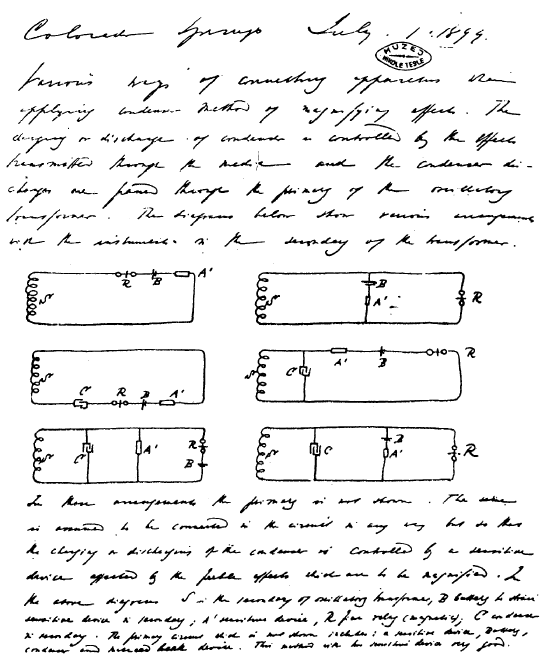
Colorado Springs
July 1, 1899
Various ways of connecting apparatus when applying condenser Method of Magnifying effects. The charging or discharging of the condenser is controlled by the effects transmitted through the media
and the condenser discharges are passed through the primary of the oscillatory transformer. The diagrams below show various arrangements with the instruments in the secondary of the
transformer.
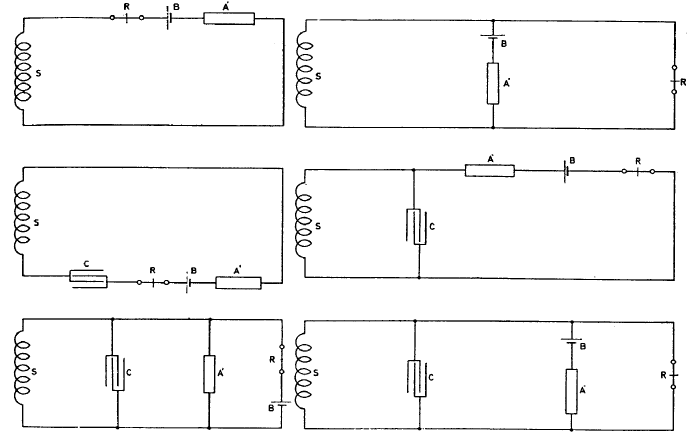
In these arrangements the primary is not shown. The same is assumed to be connected in the circuit in any way but so that the charging or discharging of the condenser is controlled by a sensitive device affected by the feeble effects which are to be magnified. In the above diagrams 5 is the secondary of oscillatory transformer, B battery to strain sensitive device in secondary; A' sensitive device, R fine relay (magnetic); C condenser in secondary.
The primary circuit which is not shown includes: a sensitive device, battery, condenser and make-and-break device. This method with two
sensitive devices is very good.
Colorado Springs
July 2, 1899
Considerations regarding best conditions of working apparatus in experimental station particularly with reference to stationary waves in the ground which will be investigated.
First assumption on which to base calculations of other elements is made by deciding on the wave length of the disturbances. This in well designed apparatus determines λ/4 or length of secondary
wound up. The self-induction of the wire is also given by deciding on the dimensions and form of coil hence Lg and X are given. For the best working of the secondary we should have the capacity
on end or free terminal just counteracting the self-induction of the secondary.
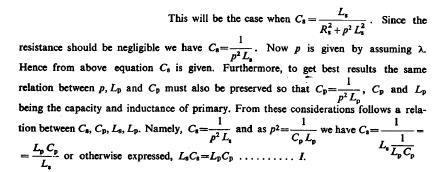
This applies to a simple case, as the one here illustrated which was one of the earliest arrangements.
The scheme of connections illustrated in Fig. 1. has the disadvantage that the primary discharge current passes trough the break hence, the resistance of the latter being large, the oscillations
are quickly damped and there is besides a large current through the break which makes good operation of the latter difficult.

To prolong oscillation in primary and increase economy one of the schemes before considered may be resorted to. One of these is illustrated in Fig. 2. which follows: in this arrangement the currents through the break device are much smaller and the oscillations started by the operation of break in circuit LpCp continue much longer.

From this relation it is evident that, other difficulties or disadvantages not considering the arrangement as illustrated in Fig. 2. should be superior to that in Fig. 1. It secures two chief advantages: 1) less current through the break and more through the primary and 2) longer and better oscillation in circuit including primary because it is easy to constitute such a system without break with an extremely small resistance or frictional waste.

Fig. 3. illustrates an arrangement similar to that shown in Fig. 2. but with a condenser in each branch. The same considerations made in regard to Fig. 2. hold good for this and in both cases, if there is to be resonance and best conditions attained, the circuit including the break should have the same period and be in phase with primary circuit LpCp and secondary LSCS.
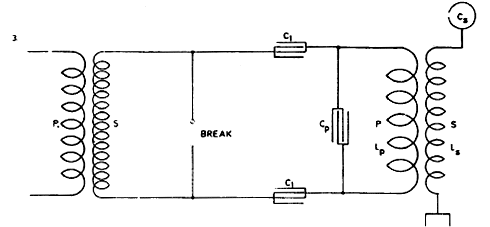
Referring to Fig. 2. as the simpler, this is the case when the relation between C1 and self-induction in this circuit is such that they annul each other at that frequency. Fig. 4 — a further modification shows the system with inductance Lx in circuit. To satisfy above conditions we must have

Rx being the resistance including the arc. Since in most cases, even with the arc included, /?, will be negligible against pL1 we have again

From all the above considerations we get a general relation between the constants of all the three circuits which is expressed by:
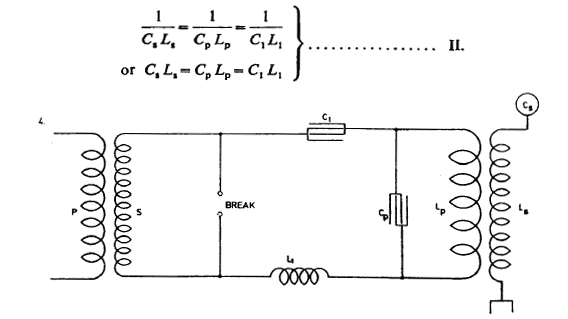
We have seen from the preceding that of the quantities considered p was given by arbitrary selection of the wave length, Ls necessarily by the wire and design of secondary and, lastly, Cs as following from the two preceding quantities. One more quantity is, however, given by practical considerations and that is C1. Namely, this capacity C1, must be sufficient to take up the entire energy of the transformer, if all things are rightly proportioned. Now let P' be the e.m.f. on the secondary of the supply transformer, then there will be stored each time in condenser C1 a quantity of energy

and if this value
be taken for the average energy stored each time and if, furthermore, the frequency of the make and break be p1 that is p1=4πn, n being number of charges per second,
or

M is here the total power of the transformer expended and expressed in watts, P' the pressure of secondary (average as defined) and
p1 as before stated the frequency of the break. The quantity C1 thus being given in each case, these remain still to be determined: Lp, L1 and
Cp.
Now it is evident that when the relation between p1, Lp and Cp exists, which is here implied, the current passes through the system as if there would be no
inductance, hence insofar as the circuit including the break, C, and L, is concerned the system Lv Cv will comport itself as if it consisted of a short wire of inappreciable resistance, the
primary being generally made of stout short conductor — therefore, in estimating the quantities of the circuit C, L, b the compound system Lp Cp may be neglected since it will have little
influence upon the period under the conditions assumed, and we may then put

Presently then all the quantities are known for determining the constants of circuit Lp Cp from two equations

Colorado Springs
July 3,
1899
In experiments with the secondary as last described, fairly good resonance was obtained with 15 jars on each side of the primary. A length of wire No. 10—170 feet — was covered with intense
streamers. The capacity — total — was 7.5x0.003=0.0225 mfd. Lp was approximately estimated 36x7x 104 cm. (six primary turns in series).
From this T=4.836 1/105 as calculated. This gives n=1/T=20,700 per sec. approx. With this vibration λ was nearly 9 miles or λ/4=2.25 miles. Actually, there was only one mile of secondary wire but owing to the large capacity (distributed) in the secondary the vibration was much slower than should be inferred from the length of wire. We may estimate the ideal capacity, which associated with the inductance of the secondary would give a vibration of the above frequency. Since there was resonance we have:


Last night the 50,000 volts transformer brought from New York broke down. This happened upon connecting to the lower end of the secondary a
condenser composed of two adjustable brass plates of 20" diam., one being connected to the ground, the other to the secondary. The plates were about 5" apart. The experiment was repeated with the
transformer after repairing it and all was found in good order.
Experiments were now continued with the secondary of 40 turns wire No. 10 just one mile long. In connection with this secondary a coil was used wound on a drum 2 feet in diam. and 6 feet long,
with wire No. 10 (cord), there being 260 turns. Approx. estimate of capacity after a previous similar estimate: 6 feet=6x 12=72"=72x 2.54= 183 cm. Half circumference of wire 0.4 cm. Area=
183x0.4=74 sq.cm. (about)=a, distance of wires about 1 cm.
This would give roughly the capacity  for one pair of wires; there being 260 pairs, total capacity would be according to this
for one pair of wires; there being 260 pairs, total capacity would be according to this  =
1532cm. =C1 (for coil). Now, the capacity in the secondary was previously found 1080 cm. Hence the total capacity of the system would be 1080+1532=2612 cm.=C. This, of course,
gives only an idea and the determination in this manner is far from being exact Consider what the period would be with the capacity and secondary and coil together as a whole. Since the coil will
have only about 12,000,000 cm. the inductance of the secondary will be the chief governing factor. Taking this at 5x 107 cm. we would have a total inductance
5x107x12x106 or (50+12)x 106 = 62 x 106 cm.
=
1532cm. =C1 (for coil). Now, the capacity in the secondary was previously found 1080 cm. Hence the total capacity of the system would be 1080+1532=2612 cm.=C. This, of course,
gives only an idea and the determination in this manner is far from being exact Consider what the period would be with the capacity and secondary and coil together as a whole. Since the coil will
have only about 12,000,000 cm. the inductance of the secondary will be the chief governing factor. Taking this at 5x 107 cm. we would have a total inductance
5x107x12x106 or (50+12)x 106 = 62 x 106 cm.
This would give

and n= 11,800 roughly. To this the primary to be adjusted for first approximate trials. Now the primary has six turns. Since one turn is approx. 7x 104 cm. we may put:

From this a rough idea of the capacity in primary may be gained. We get Cp=0.0717mfd. roughly. Taking capacity of one jar=0.003 mfd. we would want total 0.0717/0.003=24 jars approx. or 48 jars on each side of primary. This vibration would be impracticable under the present conditions as the transformer could not charge this number of jars. Although for stationary waves in ground it would be desirable to use such a low frequency the vibration will have to be quickened. An octave would require only 12 jars on each side.
This was tried and results were good although the octave vibration had only 1 /4 of the energy as the fundamental would have had. To get the
true vibration we shall want at least 8 turns in the primary with present transformer to keep the capacity in the primary within the limits given by the output of transformer. This would then
give 48 x 36/64 = 27 jars on each side. While this might do, still for best conditions not more than 16 jars should be used on each side of primary. This just taxes the transformer to full
capacity within safe limits.
Conclusion: Used about 10 turns in the primary.
Colorado Springs
July 4, 1899
Observations made last night. They were such as not to be easily forgotten, for more than one reason. First of all a
magnificent sight was afforded by the extraordinary display of lightning, no less than 10—12 thousand discharges being witnessed inside of two hours The flushing was almost continuous and even
later in the night when the storm had abated 15—20 discharges per minute were witnessed. Some of the discharges were of a wonderful brilliancy and showed often 10 or twice as many
branches.
They also appeared frequently thicker on the bottom than on top. Can this be so? Perhaps it was only due to the fact that the portion close to the ground was nearer to the observer. The storm began to be perceptible at a distance as it grew dark and continuously increased. An instrument (rotating "coherer") was connected to ground and a plate above ground, as in my plan of telegraphy, and a condenser was used to magnify the effects transmitted through the ground.
This method of magnifying secures much better results and will be described in detail in many modifications. I used it in investigating properties of Lenard and Roentgen rays with excellent results. The relay was not adjusted very sensitively but it began to play, nevertheless, when the storm was still at a distance of about 80—100 miles, that is judging the distance from the velocity of sound. As the storm got nearer the adjustment had to be rendered less and less sensitive until the limit of the strength of the spring was reached, but even then it played at every discharge.
An ordinary bell was connected to earth and elevated terminal and often it also responded. A small spark gap was bridged by a bright spark when the lightning occurred in the neighbourhood. By holding the hands across the gap a shock was felt indicating the strength of the current passing between the ground and the insulated plate. As the storm receded the most interesting and valuable observation was made. It happened this way: the instrument was again adjusted so as to be more sensitive and to respond readily to every discharge which was seen or heard. It did so for a while, when it stopped. It was thought that the lightning was now too far and it may have been about SO miles away.
All of a sudden the instrument began again to play, continuously increasing in strength, although the storm was moving away rapidly. After some time, the indications again ceased but half an hour later the instrument began to record again. When it once more ceased the adjustment was rendered more delicate, in fact very considerably so, still the instrument failed to respond, but half an hour or so it again began to play and now the spring was tightened on the relay very much and still it indicated the discharges.
By this time the storm had moved away far out of sight. By readjusting the instrument and setting it again so as to be very sensitive, after
some time it again began to play periodically. The storm was now at a distance greater than 200 miles at least. Later in the evening repeatedly the instrument played and ceased, to play in
intervals nearly of half an hour although most of the horizon was clear by that time.
This was a wonderful and most interesting experience from the scientific point of view. It showed clearly the existence of stationary waves, for how could the observations be otherwise explained?
How can these waves be stationary unless reflected and where can they be reflected from unless from the point where they started? It would be difficult to believe that they were reflected from
the opposite point of the Earth's surface, though it may be possible. But I rather think they are reflected from the point of the cloud where the conducting path began; in this case the point
where the lightning struck the ground would be a nodal point. It is now certain that they can be produced with an oscillator
(This is of immense importance)
Measurement of inductance of oscillator secondary 36 1 /2 turns on tapering frame repeatedly referred to. The approximate dimensions and form of same are indicated in the sketch.

On the base it was about 51 feet and the sides were inclined at an angle of 45°. The sides were formed of light lattice work notched for the reception of the wires. The first turn of the secondary began some distance from the ground so that the average turn was smaller than it ought to have been, judging from dimensions, that is nearly 145 feet.
Nevertheless more wire was actually coiled up owing to the fact that there was some loss in the corners, and the wire not being perfectly straight added still further to the length so that 6 coils of wire were rolled up, their lengths being: 1000+1000+1005+1002+ +762+546=5315 feet total, No. 10 B. & S. wire. Deducting ends left gave very nearly 5280 feet or a mile =1610 meters approx. The wire was wound on by the help of a stand rolled on the floor and supporting the reel. The resistance of the wire was 5.55 ohms.
The readings were as follows:
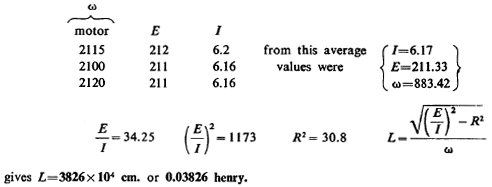
With 40 turns placed at same distance we may take approximate inductance to be about 42x 106 cm. Note: It was before assumed 5x 107 but the
turns were a trifle closer.
Readings were taken today with the synchronous 8 pole motor to ascertain ω as closely as possible for future measurements with following results:
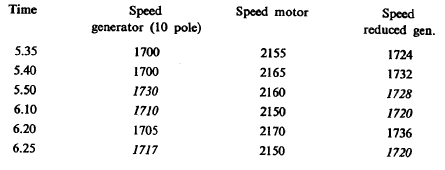
Speed of generator on station was taken by Mr. L. and on motor in exp. station by myself. The readings on generator were more liable to be underestimated. General results show that high values obtained on generator agree well with values obtained on motor. The latter can go a little faster without load. This 1 have observed with such motors before.
The reason for this may be found in the fact that the generator fluctuates about a certain average value, a greater momentum is impacted to the motor when the speed of the generator is above than when below that value. This will result in the motor making a few more revolutions than would strictly follow from the average value.
Or, the counter-electromotive force is out of phase giving higher e.m.f. on motor then on generator, thus changing amount of positive or
negative slip. Taking average from three evidently best readings we get on generator 1719, on motor 1722 which agrees fairly. Accordingly, with this generator ω will be generally 2n X 29x5=911
or, for ordinary estimates ω =900.
Colorado Springs
July 5, 1899
From older notes: Consider generation of hydrogen for balloons in the ordinary way:

From this:
98 (H2S04)+65 (Zn)=2H in lbs. Now weight of hydrogen 0.00561 lbs. per cubic foot, for filling 10 ft balloon we would want 523 x 2/3=350 cu. feet hydrogen, namely capacity of
10 foot balloon would be 523 feet but it ought to be filled only to about 2/3. This quantity of hydrogen will weigh about 350x0.00561 = 1.96 lbs.
Result: 
Now consider and compare process which some years ago occurred to me and which consists in decomposing a hydrocarbon as by an electric current heating a wire to incandescence. To get a rough idea
take, for instance, a hydrocarbon of the general composition C2H4 (not to speak of combinations richer still in hydrogen). In such a combination we have for the quantity of
hydrogen contained in it an extremely small weight. For instance, from  28 units of weight
total we get 4 unity of weight hydrogen, much more than possible in former method. In case therefore a very small weight is essentially required this method is most excellent. Now as to
electrolytic generation: 1 amp.-hour gives 37.3 milligram of hydrogen, 1000 amp.-hours
28 units of weight
total we get 4 unity of weight hydrogen, much more than possible in former method. In case therefore a very small weight is essentially required this method is most excellent. Now as to
electrolytic generation: 1 amp.-hour gives 37.3 milligram of hydrogen, 1000 amp.-hours  lbs., 0.00561 lbs per cu. foot gives 1.2 cu. feet per 1000 amp.-hours! Ridiculously small!
lbs., 0.00561 lbs per cu. foot gives 1.2 cu. feet per 1000 amp.-hours! Ridiculously small!
Colorado Springs
July 6, 1899
On a previous occasion the capacity of a coil was estimated by considering it as a series of parallel conductors and in this manner a tolerably close estimate was obtained. Applying this to the
secondary of 40 turns we would have:

This gives C in microfarad per 1 km., according to the authority. Here the length of wire total is 5280 feet roughly or 5280 X 12x2.54=-160,934 cm. Taken as a pair of conductors this would give length 160,934/2=80,467 cm.
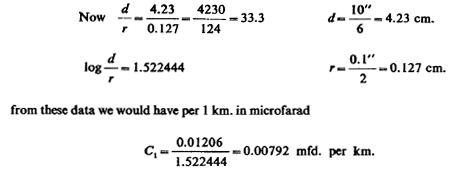
Now the length of the pair of parallel wires as supposed would be 80,467 cm. or 0.80467 km. or for the secondary the capacity would be C=0.80467xC1x2, double since both sides must be counted,
or C=0.00792x2x0.80467=0.01584x0.80467= =0.012746 mfd. or 9x 105x0.012746=1274.6x9=11,471.4 cm. Evidently this is not applicable, the
capacity could be at the utmost 3000—4000 cm. judging from the vibration of the secondary.
Colorado Springs
July 7, 1899
General conclusions arrived at after all these and previous experiences with electrical oscillators of this kind. It is important as a rule and sometimes imperative to overcome distributed
capacity. In large machines it also becomes necessary to overcome the too great self-induction since it prevents obtaining a very high frequency which is generally of great advantage. The high
e.m.f. being for the chief purposes aimed at — that is power transmission and transmission of intelligible messages to any point of the globe — essentially necessary, it is important to ascertain
the best manner to obtain it
As has been already stated this result may be reached in two ways radically different — either by a high ratio of transformation or by resonant rise. For power transmission it seems that ultimately the former method must prevail, but where a small amount of energy is needed the latter method is unquestionably the better and simpler of the two. By placing the secondary in a very close inductive relation to the primary, the self-induction is diminished so that the self-induction in a highly economical machine of this kind would not seem to be an impediment in the way of obtaining a very high frequency, at least not one which could not be more or less overcome by scientific design of the machine.
But the distributed capacity is a troublesome element in such a machine and all the more so as the e.m.f. increases. When the pressure reaches a few million volts almost all the energy is taken in charging the condenser or capacity distributed along the wire. The difficulty becomes greater still when it is realized that in an economical machine the turns must be close together, which increases the drawbacks resulting from the distributed-capacity.
Now one way of reducing the internal capacity is to place between the turns, and in series with them, condensers of proper capacity, but this is not always practicable. This will be later considered more in detail. By such means the full rise of pressure on the terminal or terminals of the secondary may be obtained, which is impossible with distributed capacity of any magnitude. Very often only a small rise at the terminals can be obtained as all the charge remains "inside".
Now as to obtaining the required pressure by a resonant rise there are again two ways: either to place a secondary in loose connection to a primary thereby enabling the free vibration of the secondary to assert itself, or using a secondary in intimate connection with the primary and then raising the pressure by an additional coil — extra coil — or inductance not in inductive relation to the primary. The latter method I have found preferable when a very high e.m.f. is desired.
More particularly for purposes of telegraphy to any point of the globe which is one of the objects, I conclude that:
1) ratio of transformation should be as large as practicable with reference to the preceding;
2) magnifying factor of coil as large as possible;
3) minimum internal capacity;
4) high self-induction in coil for sharp tuning.
Experiences up to present indicate flat spiral form of coil in sections as best suitable.
Rough estimate of period of vibration to be adopted with Westinghouse transformer 40,000 — 60,000 volts.
Required: that only one turn of primary be used because of 1) high ratio of transformation to be attained and 2) facility of regulation with the Regulating coil brought from New York. Now the
total output of W.E. Transformer will be, say, 50 H.P. (though the machine may be strained to many times that output). From this follows the number of jars which it will be possible to use. We
have 50x750=1/2 x 60,0002 x 300 x C, assuming now 150 cycles per second, a little more than is likely to be the case.
From this follows  farad or in
centimeters we would have the capacity of condenser which the transformer will be able to charge without considering resonant conditions or other causes which may enable the transformer to charge
many more jars
farad or in
centimeters we would have the capacity of condenser which the transformer will be able to charge without considering resonant conditions or other causes which may enable the transformer to charge
many more jars  cm. total. Now taking the capacity of one jar as 0.003 mfd. or 2700 cm.
this would give only 62,500/2,700 = 625/27=23 jars total, or in two series 46 jars on each side of primary. The capacity of new jars will be probably 0.0025 and a correspondingly greater number
may be taken.
cm. total. Now taking the capacity of one jar as 0.003 mfd. or 2700 cm.
this would give only 62,500/2,700 = 625/27=23 jars total, or in two series 46 jars on each side of primary. The capacity of new jars will be probably 0.0025 and a correspondingly greater number
may be taken.
With 40,000 volts we would be able to take 36/16x23=nearly 52 jars total or 104 on each side. Assuming 60,000 volts and say 48 of new jars on each side this would give capacity in the primary most suitable to the transformer 24x0.0025=0.06 mfd. and the inductance of the primary being say 7 x 104 cm. The period T would be
 per second.
per second.
Colorado Springs
July 8, 1899
Further conclusions relative to the best working conditions and constructional features of such oscillators derived from observations made in these and previous experiments. Beginning with the
primary, the capacity should, as stated before, be best adapted to the generator which supplies the energy. This consideration is, however, of great importance only when the oscillator is a large
machine and the object is to utilize the energy supplied from the source in the most economical manner.
This is the case particularly when the oscillator is designed to take up the entire output of the generator, as may be in the present instance. But generally, when the oscillator is on a supply circuit distributing light and power the choice of capacity is unrestricted by such considerations. In most cases the advantages secured by using a very high frequency are so pronounced that the primary circuit will have to be designed with this feature in view.
The resistance of the primary circuit should be in any event as small as it is practicable to make it. I also think that generally, the inductance should be as small as practicable for that frequency which is supposed to be arbitrarily selected beforehand. When, however, the break number is comparatively small, that is, much smaller than the number of free vibrations, it is of great advantage to have the inductance great in order to give a greater momentum to the circuit and to thus enable it to vibrate longer after each break.
But if the break number is of a frequency comparable with that of the free vibrations, the inductance should be as small as possible for however small it be, the circuit will generally vibrate long enough. One more reason why the inductance should not be large in such a case is that, in the primary, it is unnecessary to raise the pressure by making pL/R very large.
Necessarily this factor R will be large in a well designed circuit, but should be so chiefly owing to an extremely small resistance and not
owing to a high self-induction. By making the inductance smaller a greater capacity may be used and this will give a greater output, a feature which is sometimes of importance. Of course, as the
capacity becomes large the difficulties in the make and break device increase, but with a properly designed mercury break these difficulties are in large measure overcome. I conclude from the
above facts that the best way to construct a primary in such a machine is to use thin sheet of copper or at any rate a stranded
.cable. I have settled upon using copper sheet in the smaller machines since long ago, this giving the best result. By using sheet a very small inductance is obtained and more length of conductor
can be wound on for same frequency, at the same time the opportunity for radiation is excellent and the construction is .simple and cheap. For the same section sheets much less than cable and the
difference in this respect is so marked that I have been tempted to believe that there is a special reason for it, not yet satisfactorily explained.
The actual length of the primary conductor, relative to that length which is obtained by dividing the velocity of light by 2n, n being the number of vibrations of the primary per second — is of little importance since the primary is generally but a very small fraction of that length, but I believe to have observed that it is preferable, in a slight degree, to make the conductor of such a length that, if l be this length and n the frequency, 2 Knl should = v, the velocity of light, and K should be a whole number and not a fraction.
At least this seems to hold good in circuits made very long expressly for the purpose of ascertaining whether there is truth in this idea which was arrived at by considering the ideal conditions of such a vibrating circuit. In this abstract case / should be rigorously equal to that half wave length which is obtained by computation from the velocity of light.
In practice it is invariably observed that l is smaller and K is not as it should be = 1 but is often large number, this simply
following from the fact that the velocity of propagation in a circuit with considerable inductance and capacity is generally much smaller than that of light and often considerably smaller. It is
to be stated that for a number of reasons it is of advantage, whatever be the actual length of the primary conductor, to arrange it so that it is symmetrical with respect to the condenser and the
make-and-break device, one of the chief objects being to secure the maximum difference of potential on the terminals of the condenser. This consideration leads to the adoption of at least two
condensers in series, the primary generally joining the outer coatings while the inner ones are bridged by the break device.
Coming now to the secondary quite different considerations apply. First, we must decide whether the secondary high electromotive force is to be obtained exclusively or entirely by transformation
as in the commercial transformers with iron core, or not. In the first case obviously similar rules of economic design as followed in ordinary transformers will have to be respected.
The secondary will have to be placed in the closest possible inductive relation to the primary and this will give an economical machine and one of relatively high frequency, since the inductances of the circuits by mutual reaction will be considerably reduced. But it is at once seen, that in a machine as here chiefly considered for the purposes followed from the outset, the connection between the primary and secondary can never be as close as in ordinary transformers, and the connection must be all the less intimate as the pressure on the secondary is increased since the wires must necessarily be placed at a greater distance from each other.
From this it follows that in such a machine the free vibration of the secondary can never be quite ignored even if the electromotive force is not extraordinarily high. Now directly as the free vibration of the secondary becomes an important element to consider in the design, the careful adjustment becomes obviously imperative. It goes without saying that pL/R should be as large as possible in all cases where resonant rise is one of the objects.
But here is where we find in practice, and particularly in a large machine, difficulties not easily overcome. Both the inductance and capacity grow rapidly as turns are added, so much so that very soon it is found the secondary period becomes together that of the primary. The chief drawback is, as has been already pointed out, the distributed capacity but also the inductance though in a lesser degree.
While the inductance in a certain sence has a great redeeming feature and is necessary, yet it stands in the way of obtaining a very high frequency in a large machine. To get a high electromotive force we must have many turns or turns of great length and this means great inductance and this again entails the drawbacks of slow vibration. Thus, in a large machine we encounter those difficulties which meet us in the design of too large a bridge, for instance, difficulties which are based on the very properties of matter and seemingly insuperable.
Make a wire rope of twice the section and it will not be able to carry a longer piece of its own, since the weight is increased in the same proportion as the section and the strain per unit of the latter remains the same. Fortunately for us in electrical machinery, of this kind at least, this limit is immensely remote owing to the wonderful properties of this agent
Still the difficulties encountered on account of the capacity and inductance, and usually on account of the insulation are such as will require great deal of persistent effort to be effectively done away with in these oscillators, if the results aimed at are to be achieved in a thoroughly practical manner. Much attention will be devoted to this part of the problem in perfecting the machines which are necessary for the successful carrying out of the projects of transmitting power as well as effecting communication with any point irrespective of distance.
But the machines for these two purposes will necessarily differ in design, since in one case — the first — a great amount of energy is imperative, while in the other only a high electromotive force and immense rate of momentary energy delivery is required.
The two most promising lines of development are evidently these two: either to obtain the necessary electromotive force in a secondary alone, or
in an extra inductance, not affected inductively by the primary or even by the secondary but merely excited by the latter, the rise of pressure being due to a great magnifying factor. The latter
method has been found to be by far the best when a high e.m.f. but not a great amount of energy is required and there is scarcely any limit to the maximun pressure so producible. But it does not
seem to me as though this method should be applied in power transmission contemplated, but this will be decided in the future.
Recognizing in the distributed capacity the chief drawback, I have since long thought on ways of overcoming it and the best seems to be so far, to make the secondary in sections of the determined
length and to join them all in series through condensers of the proper capacity. By this means the greatest possible length of conductor may be utilized by a given frequency and placed in good
inductive connection with the primary.
Theoretically it is possible to entirely do away with the effect of distributed capacity in this manner and to use an excessively large
inductance and consequently a large magnifying factor as well as magnifying transformation ratio. The wave length in such a theoretical case will be then exactly that which follows from the
velocity of propagation of light.
Various arrangements experimented with for the purpose of studying effect of diminished inductance of secondary.
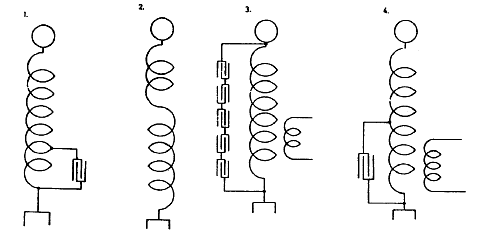
-
In Diagram 1. one part of the secondary was used as primary, this part being shunted by the primary condenser;
-
in 2. a few turns of the secondary, those remote from the primary, were wound opposite;
-
in 3. a series of condensers capable of standing the entire pressure of the secondary were used to shunt the same;
-
in 4. a larger part of secondary inductance was counteracted by a condenser;
-
in 5. the entire secondary inductance was counteracted by a condenser;
-
in 6. the inductance of the secondary was reduced by placing the turns far apart;
-
in 7. inductance was counteracted by a series of condensers inserted between the turns and also distributed capacity was reduced and
-
in 8. (not shown) static screeening was resorted to.
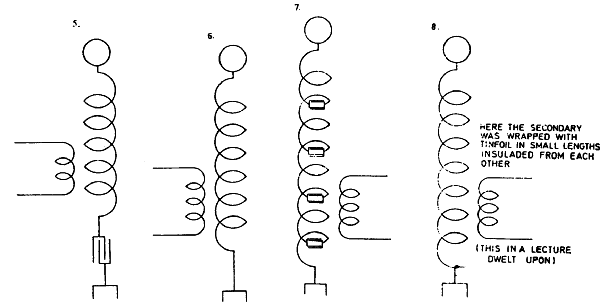
Colorado Springs
July 9, 1899
To ascertain to what extent the distributed capacity of secondary wire No. 10 was responsible for the small spark length obtained on the free terminal and to further study this capacity effect,
wire No. 31 is to be wound on the secondary frame. For these experiments the present transformer brought from New York is to be used — which can charge just about 16 jars, as now operated, on
each side of the primary, this giving primary capacity = 8 jars or 8x0.003=0.024 mfd. Since L with connections (1 primary turn) is  henry, the period of the system to be adopted for new experimental
henry, the period of the system to be adopted for new experimental
coil of this wire will be:


This to follow up.
The effects of distributed capacity in some experiments with the secondaries constituted of wire No. 10 (or cord) were so striking that it seemed worth while to carry on some investigations with
very thin wire and consequently very small capacity in the secondary. It was decided to use wire No. 31 in these experiments.
The diameter of this wire was only 1/11.4 of that of wire or cord No. 10 hence the capacity of the new secondary, assuming all other things to remain the same, would be only 1/11.4 of the capacity of the old secondary. The capacity of the new coil would be, however, reduced or increased in proportion to the length of the new wire relatively to the old and would be furthermore regulated by the distance of the turns.
It was resolved to adopt 122,000 per second (see note before) in the primary as compared with 21,000 per second with the old secondary which was obtained with 15 jars on each side of the primary. For this vibration (122,000) the length of the new secondary should be about 2000 feet, this being the length of a quarter wave. Calling now the distance between the turns of the new coil d, its capacity as compared with that of old secondary of a length of 5280 feet would be:
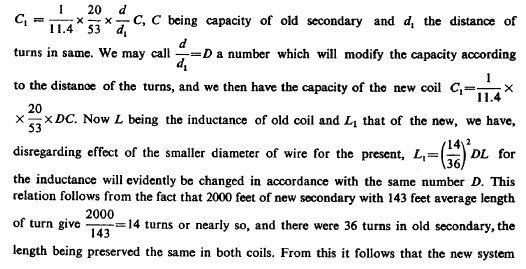
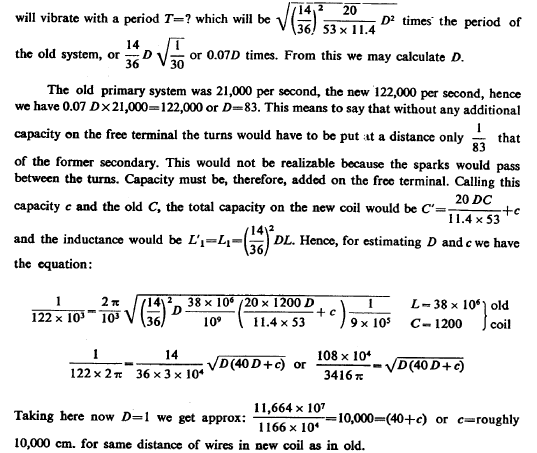
It was of interest to determine the period of the combined primary and secondary system of the experimental oscillator and the following method was adopted. A coil wound with thin wire, turns separated by a string to reduce distributed capacity, was placed at a distance of a few feet from the vibrating system and so that it was about equally affected by the primary and secondary. One end of the coil was connected to earth and the other end was left free.
An idea was already obtained beforehand as to the frequency which was likely to be found but more wire was wound on the coil to enable the adjustment to be effected by taking off turns. Turns were then taken from the lower end of the coil until a maximum of spark length from free terminal was obtained. The coil then gave a spark 5" long. This took place when there were 1140 feet of wire on the coil, this length being found by measurement of resistance

Neglecting the capacity of the coil this length should be =λ/4 or the quarter of a wave length. Of course, it was less but it was surmised that it would not be very much less. The total length of wave was then λ=4560 feet. From this would follow

Now the capacity in the primary circuit was ten new jars on each side, this making a five jars total or 5x0.0025=0.0125 mfd. or 125/104 mfd. From this the period of the system ought to have been
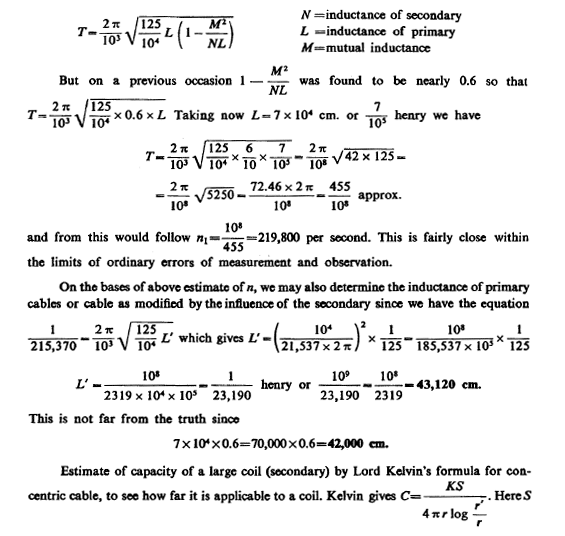
Here S is the surface of inner copper conductor, r' radius of inside hole of conductor outside of cable, r radius of copper conductor inside (Diag. 1.). Assuming now a cable wound up having n turns at a distance d, each turn may be considered as having a conductor on either side at distance d.
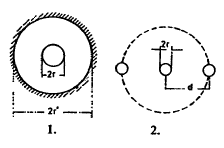
If we draw a circle of radius d around the conductor and imagine the inner surface conducting, we have the capacity of such a system according to above formula. Now in the case of a coil of this ideal surface we utilize only a small part which is approximately, when d is very large compared to

Now if there are n turns there will be (n—1) such systems as illustrated in Diagram 2. Taking air as insulation and neglecting the effect of the small thickness of other dielectric, we would then have the total capacity:

being the length of one turn. The values calculated out in this particular case of a secondary of 37 turns (36 1/2+connecting wires=approx. 37 turns) are as follows:
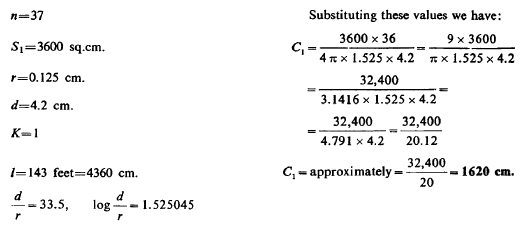
This is not far from the value found. It shows that an approximate estimate may be made in this manner.
Colorado Springs
July 10, 1899
The following consideration conveys an idea of the drawbacks of distributed capacity in the secondary. Suppose the total capacity of 12 such large turns would be 1200 cm. as may be frequently the
case, or 100 cm. per one turn and now let us ask to what potential this condenser may be charged — assuming further the energy to be carried away for the performance of work — by expending 1 H.P.
In this case we would have

Here P is the potential, n the number of vibrations per 9xl0 ux2 second. In our case n may be 20,000 and then we may put
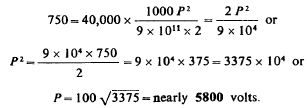
This shows that by only charging the internal capacity to the insignificant pressure of 5800 volts we would have to expend 1 H.P. Of course,
normally the power is small although the capacity is charged up to a much higher potential, but the consideration shows why with a large distributed capacity a very high pressure can not be
obtained- on the free terminal. All the electrical movement set up in the coil is taken up to fill the condenser and little appears on the free end. This drawback increases, of course, with the
frequency and still more with the e.m.f.
In accordance with the preceding, an experimental coil of No. 31 wire (No. 30 not being on hand) was wound on the secondary frame. In the first experiment 14 ' /2 turns were coiled up. The
results were disappointing and for some time mystifying. This induced e.m.f. ought to have been 14 1/2 times the primary less 40% of total as before stated, but it did not seem so. Finally it was
recognized that, as the capacity of the new secondary was very small, the free vibration of the coil was very high hence no good result could be obtained.
The capacity in the primary was now reduced until to all evidence resonance was obtained, but the results were much inferior to what might have been expected, probably because pL/R was small owing to large resistance. One of the reasons was, however, that the capacity in the primary was too small to allow a considerable amount of energy to be transmitted upon the secondary.
To better the conditions, one of the balls of 30" diam. was connected to the free terminal; this allowed a greater number of jars in the primary
to be used but the capacity of 38.1 cm. was by far too small to secure the best condition of working. The resonating condition in secondary was secured with approximately 7 jars on each side of
the primary and when the ball was connected with about 14 jars.
The capacity of the secondary was estimated to be 40 cm. and the inductance approx 
Note: In these estimates I consider not the actual distributed capacity, but an ideal capacity associated with the coil.
This gave period of secondary roughly:

From this n= 195,000 per second. This vibration was far above that of the primary circuit working under favorable conditions, that is with the full number of jars. As the thin secondary did not yield any satisfactory results a coil was now associated with it. It was one used in some experiments before, having 260 turns of cord No. 10 (okonite) wound on a drum 2 feet in diam. and 6 feet long.
The total length of wire was 1560 feet and the capacity of the coil (as above) 1530 cm. This coil was connected to the free terminal of the secondary and the free end of the coil was placed vertically on the top of the same and in the prolongation of its axis. Fairly good resonant rise was obtained on the free end, the streamers being 2 1/2—3 feet long.
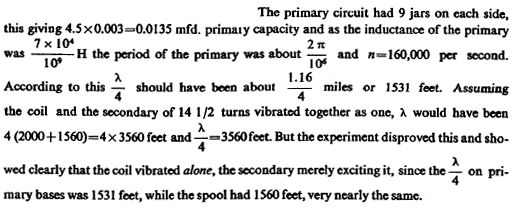
For best results secondary should have been tuned to the same period as that of the coil. Conclusion of experiments with thin wires was: results
must be inferior as free vibration is important.
In using wire No. 30 in the experiments proposed instead of wire No. 10 in the present secondary, we shall have to consider the following: the largest number of jars would be 154 on each side of
the primary and with one primary turn which it is advantageous to use on account of facility of adjustment We would have, as before found,

The wave length will be:

before, wound on the secondary frame and placed at twice the distance, the distributed capacity will be not far from 1/2 x 1/10 or 1/20 of that
of the old secondary. The inductance of the new coil — neglecting effect of small diameter of No. 30 wire — will be one half of the old, hence the new system will vibrate  times quicker than the old secondary system. Since the old system vibrated 21,000 per sec. the new
will vibrate 6.3 times that or 132,000 times per second, this number being —n.
times quicker than the old secondary system. Since the old system vibrated 21,000 per sec. the new
will vibrate 6.3 times that or 132,000 times per second, this number being —n.
We should now, for the best suitable conditions, make the new system vibrate only about 1/3 that number since this would be approximately the
vibration of the primary system, as above stated. Now taking the capacity of the old secondary 1200 cm., that of the new would be only 1200/20=60 cm.; we would have, therefore, to bring the pitch
down to make the capacity 9 times as large or 9x60=540 cm. or we would have to put about 480 cm. on the free terminal of the new coil.
Further consideration in using a new secondary of No. 30 wire. The length of 1 mile of this wire will have a resistance on the basis of 9.7 feet per ohm from tables 5280/9.7= 544 ohms
approx.
To get a rough idea of how the coil might work suppose that on the primary there would be 40,000 volts and that there were 36 turns of secondary, then there would be theoretically an e.m.f. on the terminals of secondary 40,000x36=1,440,000 volts and, deducting with reference to mutual inductance 40%, we would have 1,444,000x0.6= 864,000 volts impressed or induced e.m.f.
Suppose now we had a capacity of 480 cm. on the free terminal as before estimated, the charge stored in this condenser would be:
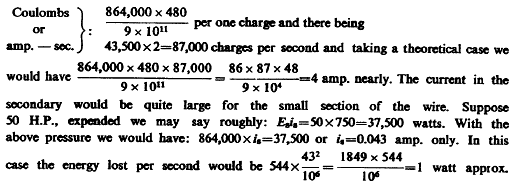
The loss in this case, in spite of the great amount of energy transformed, would be ridiculously small owing to the great e.m.f. despite
comparatively high resistance of the secondary. But this only seems so, for 544 ohms would be extremely small resistance for such e.m.f. The theoretical case above considered is hardly
realizable, it would require an immense amount of energy.
Additional coil used before in some experiments, also in trials with a secondary of No. 31 wire.
Approximate inductance of coil
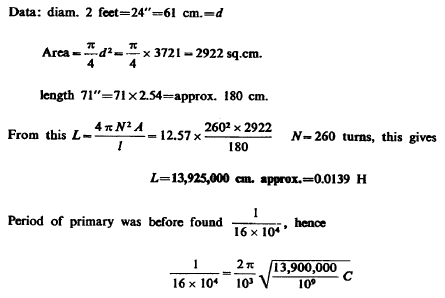
From this a rough idea of the capacity of the coil may be had, resonance being observed when the primary had  as above. From above equation we find
as above. From above equation we find

This is a much smaller value than would be expected from previous approximate estimates. The correctness of the value found depends, among other things, chiefly on the correct determination of the period, for resonance might have been also obtained with a lower or upper harmonic, but this is not very likely to be the case as the vibration was very intense. There were approximately 5000 volts on primary turn.
Resistance of coil was

Next Page
Colorado Springs
July 11, 1899
Some considerations on the use of "extra coils". As has been already pointed out an excellent way of obtaining excessive electromotive forces and great spark lengths is to pass the current from a
terminal of an oscillating source into such a coil, properly constructed and proportioned, and having preferably a conducting body — best a sphere — connected to the free terminal. In free air
the highest economy is obtained with a well polished sphere, but for the greatest spark length — if this be the chief object — no capacity on the free terminal should be used, but all the wire
should be carefully insulated so that streamers can not form except on the very end of the wire which as a rule should be pointed.
This, however, is not always true. When the apparatus delivers a notable amount of energy the curvature of the end of wire or terminal attached
to it should be such that the streamer breaks out only when the pressure at the terminal is near the maximum. Otherwise, very
-often, when a finely pointed terminal is employed the streamer begins to break out already at a time when the e.m.f. has a small value and this reduces, of course, the spark length and power of
the discharge. By careful experimentation and selection of terminal the most powerful spark display is easily secured which the particular apparatus used is capable of giving. When the conditions
are such that for the most powerful discharge a terminal of some, relatively small, curvature is needed, the curvature of the terminal can be beforehand calculated so that the discharge will
break out at any point of the wave desired, when the e.m.f. at the terminal has reached any predetermined value.
The greater the curvature of the terminal the smaller an electromotive force is required to enable the discharge to break out into the air. In fact, the curvature or the terminal may serve as an indication of the value of the e.m.f the apparatus is developing and it is often convenient to determine the e.m.f. approximately by observing how large a sphere will just prevent the streamers from breaking out, and for such purposes I have found it useful to provide the laboratory with such metallic spheres of different sizes up to 30" diam. It is of course necessary to guard in such experiments against errors which might be caused by any modification of the constants of the vibrating circuit through the addition to the system of a body of some capacity.
The latter should be such as to insure the maximum rise of the pressure. With apparatus of inadequate power the pressure may be very much diminished by the addition of capacity merely because there is not enough energy available to charge the same to the full pressure. It is a notable observation that these "extra coils" with one of the terminals free, enable the obtainment of practically any e.m.f. the limits being so far remote, that I would not hesitate in undertaking to produce sparks of thousands of feet in length in this manner.
Owing to this feature I expect that this method of raising the e.m.f. with an open coil will be recognized later as a material and beautiful advance in the art. No such pressures — even in the remotest degree, can be obtained with resonating circuits otherwise constituted with two terminals forming a closed path. It is also a fact that the highest pressure, at a free terminal, is obtained in that form of such apparatus in which one of the terminals is connected to the ground. But such "extra coils" with one terminal free may also be used with ordinary transformers and by using one such coil on each of the terminals of the transformer, practically any spark length may be reached.
Of course, it is desirable that the frequency of the currents should be high, as with the common frequencies of supply circuits the lengths of the wires in the coils become too great. In the diagrams below the two typical arrangements with such an "extra coil" or coils are illustrated in which Diagram 1. illustrates their use with an ordinary transformer, which may have an iron core or not, and Diagram 2. shows typically the connection as I use it in my "single terminal" induction coil.
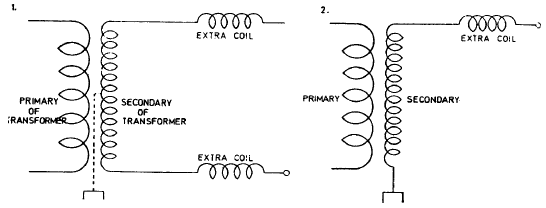
As has been stated on a previous occasion in connection with this subject, to enable a considerable rise of pressure to take place in a circuit,
the same must be tolerably free from inductive influences of other circuits. It follows from this that, although with a secondary in loose connection with a primary a very high pressure is
obtainable, yet the pressure will never be as high as when an "extra coil" not in inductive connection with the primary is employed to raise the pressure, because the secondary always reacts upon
the primary thus dampening the vibration, while the "extra coil" does not react in such a manner, the rise of pressure being simply due to the factor pL/R.
The object of the considerations which follow is to establish simple relations between the quantities which are known or adopted beforehand, so as to enable the experimenter to construct such
coils without previous trials.
Calling E0 the impressed e.m.f. and E the pressure measured with reference to the free terminal — that is the maximum pressure, p the product 2πn as usual, L the inductance of the
"extra coil" and R its resistance, we have the known relation  .
.
Obviously the maximum rise will take place when the period of the excited system or "extra coil" is the same as that of the oscillating system impressing the movement, for although the results obtained with a lower or upper harmonic, and particularly the former, may be sometimes so remarkable, as to be mistaken for effects of the true vibration, they are nevertheless always inferior, and I as a rule try the first upper and undertones to be sure of the result, when there exists any doubt in this respect In ordinary practice the first element which is given will be the frequency, hence the wave length must be assumed as the first fixed quantity.
But as has been already stated on another occasion, in an apparatus designed to give the best result the actual length of the wire should be that which is obtained on the basis of a velocity of propagation v equal to that of light I have already remarked before that this is generally not true, the actual length of wire being always smaller than the theoretical length, and I propose to put together data derived from many experiments with coils wound with different wires and varying in size, from which it will be possible to always obtain, beforehand, with any particular wire, insulation and size of coil etc. the length required — by multiplying the theoretical length with a coefficient dependent on these and other particulars of this kind, different in special cases. Such coefficients will be certainly useful to the practitioners.
The chief dement determining the length of the wire is the distributed capacity and I shall presently suppose, that by proper design it is so reduced, that the length of wire is very nearly equal to the theoretical length, or the length of one quarter of the wave as computed from the velocity of light In this case then, if l be the length of wire in the "extra coil", and X this wave length, the length
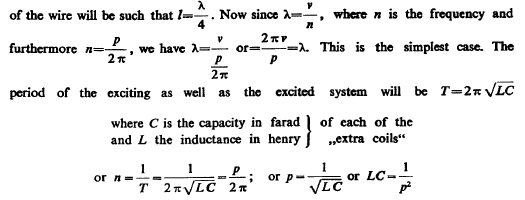
This condition, as is well known, must be fulfilled, whatever be the length of the wire, to enable the maximum rise of pressure to take place, and also, p must be the same number for both systems, obviously. Now evidently in designing the apparatus, in any case, the experimenter will know approximately what e.m.f. he would wish to secure, and consequently he will have an idea how much difference of pressure he will have between the turns, and this will give him again an idea how he must place the windings most advantageously. He will furthermore recognize at once that the simplest form of such a coil, and also the cheapest will be one with one single layer and, settling upon this form, he will get an approximate estimate as to the diameter of the coil to be adopted.
This will, of course, depend much on the kind of wire he uses and particularly on the insulation, since the better the insulation the closer will be two points of the coil between which there will exist a certain maximum pressure. Granted now the diameter of the coil to be constructed is settled upon, it will be at once seen that, assuming turns are wound on until resonance is obtained, the inductance of the coil and the capacity of the same will vary in the like manner.
If more turns are wound on the drum their number will be proportionate to the length of the coil, therefore to the length of the wire, and the inductance will be proportionate — on the one hand, to the square of the turns or respectively to die square of the length of the wire, and on the other hand, it will be inversely proportionate to the length of the coil. Inasmuch as this length is likewise proportionate to the length of the wire, the inductance, on the whole, will be proportionate to the ratio p/l or to I, that is to say, the inductance of the coil, as more turns are wound on, will grow as the length of the wire.
And so will also, and obviously, the distributed capacity. And furthermore, and for the same reasons, under the conditions considered, both the capacity and the inductance of the coil will vary inversely as the distance of the turns which I shall designate τ. This is dear since, as far as the inductance of the coil is concerned, the number of turns will be inversely as τ, and the length of the coil directly as τ, hence the inductance will be inversely as τ; and, as regards the distributed capacity, it will be, of course, inversely proportionate to τ. Hence we can express both the unknown quantities L and Cr (distributed capacity) in terms of / and τ.
But it should be remembered that in the equation  , C is capacity associated with the coil on the free terminal and not the distributed capacity. In case, therefore, we should make the capacity on the free terminal very large in
comparison with the distributed capacity of the coil, or if capacity be associated with the coil in other ways, as by shunting the coil with a condenser as in sketch 3. — or in any other way, but
so that the distributed capacity may be neglected, then the design of the coil is much simplified, for then one of the constants, preferably C, can be adopted beforehand and the other constant
calculated. It will be in such case better to adopt first a capacity, because it is easy to get an idea of what kind of condenser to use when the pressure of the terminals of the coil is
approximately known.
, C is capacity associated with the coil on the free terminal and not the distributed capacity. In case, therefore, we should make the capacity on the free terminal very large in
comparison with the distributed capacity of the coil, or if capacity be associated with the coil in other ways, as by shunting the coil with a condenser as in sketch 3. — or in any other way, but
so that the distributed capacity may be neglected, then the design of the coil is much simplified, for then one of the constants, preferably C, can be adopted beforehand and the other constant
calculated. It will be in such case better to adopt first a capacity, because it is easy to get an idea of what kind of condenser to use when the pressure of the terminals of the coil is
approximately known.
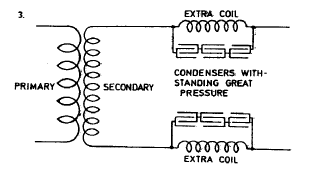
A practical way is, to adopt a construction before suggested, securing a negligible internal capacity consisting of the placing of condensers in series with the turns of the coil and then, merely calculating one of the constants, assuming first a value for the other constant, whichever is the more convenient of the two. I have also found it practicable in some cases to avail myself of some methods of tuning allowing exact observations as to the rise of -pressure in the excited circuit, and to tune a small number of turns first to a much higher "Harmonic and, after completing this adjustment, to calculate the dimensions of the coil for the fundamental vibrations from the experimental data secured.
But in most cases such resources are not readily available and an approximate idea must be gained in other ways. There are a number of different
considerations which, when followed out in connection with the preceding, will lead to the establishment of simple relations between the quantities primarily adopted and will enable an
experimenter to construct such a coil to suit source, without previous experiment and some of these I propose to consider on other occasions. Presently I shall indicate a way which, in some cases
to which the calculated data were applied, has given satisfactory results.
The ideal capacity C which should satisfy the equation  is always a function of the
distributed capacity C, and furthermore a linear function, so that C=K1C1, where K1 is a constant, the value of which is to be deducted from the results of many
varied experiments carried on to this end. But this capacity C1 is, as has been found in many experiments with coils of widely different dimensions, directly proportionate to the
length of wire and to the diameter of the same and furthermore to the diameter of the drum. The latter will be understood when it is considered that the greater the diameter of the drum the
greater is the potential difference between the turns and, consequently, the greater is the amount of the energy stored in the coil with a given length and diameter of the wire.
is always a function of the
distributed capacity C, and furthermore a linear function, so that C=K1C1, where K1 is a constant, the value of which is to be deducted from the results of many
varied experiments carried on to this end. But this capacity C1 is, as has been found in many experiments with coils of widely different dimensions, directly proportionate to the
length of wire and to the diameter of the same and furthermore to the diameter of the drum. The latter will be understood when it is considered that the greater the diameter of the drum the
greater is the potential difference between the turns and, consequently, the greater is the amount of the energy stored in the coil with a given length and diameter of the wire.
Finally the quantity C1 is inversely proportionate to the distance of the turns τ. As to the dielectric constant it is only then important
to consider when the turns are quite close together so that the entire space between the turns is filled with the dielectric. When the turns are far apart this constant may be taken=l. From this
it follows that the capacity C
Ddl interpreted as above may be expressed by the following equation:  when
when
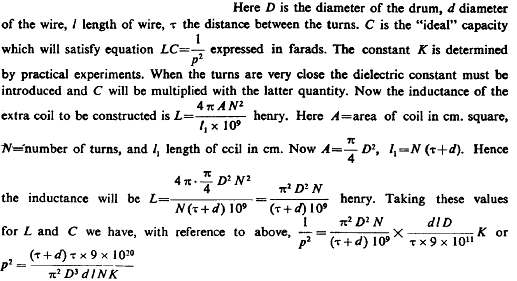
Since in the preceding the diameter of the drum is assumed, from practical considerations it will be convenient to find the number of turns N. The quantities D and T are, of course, interconnected since by assuming D and deciding on the pressure to be obtained beforehand, x is practically given. The diameter of the wire will in most cases also be selected beforehand so that then merely N is to be determined to satisfy the condition of resonance for any frequency specified. Now l=πDN hence substituting this we have from above:

This formula may serve to give an approximate idea of how many turns are to be wound on in cases when the length of the wire, owing to the capacity in the excited circuit, X / X is smaller then λ/4 (or respectively smaller than λ/2 if the circuit is not one of the kind illustrated in diagrams above — that is, one in which the potential on one terminal is many times higher than on the other, but an ordinary circuit, in which there is a symmetrical rise and fall of pressure at both the terminals), but the equation assumes that K, the dielectric constant, is= 1 or nearly so.
From a number of experiments the value for AT with wire No. 10 as used in preceding experiments was found to be nearly = 52/106. Introducing this value in equation for N and reducing the constant quantities we find

To see how close this formula will give the value of N in a special case take, for instance, the secondary with 40 turns experimented with before. In this particular case we have the following data: diameter of coil, average, 40 feet=480" =1220 cm. approx.

Resonance in secondary from previous tests took place with the primary period being  , this was also the secondary period and from this n=20,700 approximately and this gives p=
130,000 very nearly. On the basis of these data we would have:
, this was also the secondary period and from this n=20,700 approximately and this gives p=
130,000 very nearly. On the basis of these data we would have:
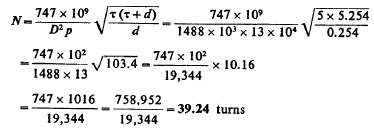
This comes indeed very close, the turns being actually 40 for the condition of re
Colorado Springs
July 12, 1899
Self-induction coil for condenser method in conjunction with oscillating transformer. Adapted to Thomas clockwork and condenser 1/2 mfd. mica on hand (one of the two small condensers). Capacity
given 1/2 mfd., break also given: wheel of clockwork breaking and making contact has 180 teeth, turns about 20 a minute. This gives breaks =60 60 per second.
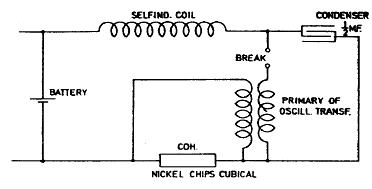
Here at each make and break we have a wave in the condenser, and tuning may be effected either by making n=60 or n—30. Best result seemingly, from former experiments with oscillators, seems to make n=the number of breaks. We have then,
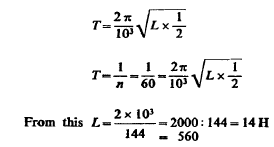

Follow up.
Colorado Springs
July 13, 1899
Considerations regarding working of oscillator without spark in secondary. This is a considerable advantage because of economy and also facility of exact synchronous adjustment When spark used
the latter difficult as capacity is changed by varying distance of terminals, also because spark establishes short circuit temporarily. In general, the process is very complicated and the tuning
only partially successful.
But using spark allows obtaining of great suddenness and using short wave lengths. The shortness of waves gives high e.m.f. and, therefore, great effect at distance. Without spark it is difficult to obtain high e.m.f. with short waves. Long waves on the other hand are less absorbed and allow exact tuning. Following plan seems to offer particular advantages that seemed to work well in New York oscillator.
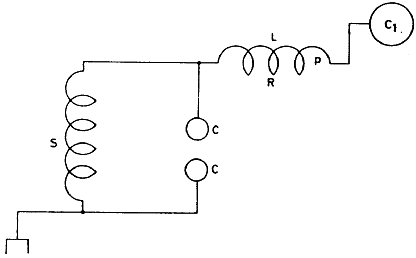
S is the secondary of oscillator. To this is connected a coil L with capacity C,. The secondary is shunted by a condenser C C. This condenser can be of large spheres when practicable. No spark should go over the spheres C C and streamers should be prevented. Now the adjustment may be such that system L C1 is any upper harmonic. In this system Lp/R should be as large as possible. The free vibrations of L C1 can be transmitted upon earth through condenser C C.
Colorado Springs
July 14, 1899
Further considerations in regard to producing most effective movement without spark gap in secondary. 2) A way which was experimented with in New York about a year and a half ago and worked
exceedingly well and also later with boat, was to produce a very quick primary vibration and induce currents in secondary of a few turns which has one of its ends to earth and the other connected
to a large capacity. Connections were as illustrated.
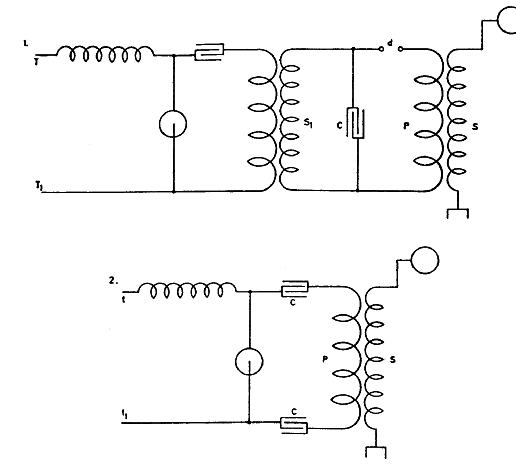
Fig. 1) supply direct current 220 volt. Mercury break 1600 per second. The secondary S1 with small condenser C and spark gap d,
primary P 2—3 turns.
Fig. 2) supply circuit about 600 V; small condensers C C, 1/2 mfd. each, 1 turn primary. Both of the arrangements worked well, that illustrated in 2) more economical but waves longer.
3). Another way (and seemingly best) is to provide a secondary which consists of a number of elements comprising condenser and coil each of a high frequency of vibration and all joined in series.
The primary vibration should be quick corresponding to that of each of the elements of the secondary. In this manner any e.m.f. may be secured, the secondary may be of any length yet it will
vibrate quick.

(To be followed up)
Colorado Springs
July 15, 1899
Some arrangements in telegraphy involving the Dynamo principle (first brought to Page some years ago). Present apparatus built two years ago in New York, worked very well. Consider which the best
of the following modifications:

In case 1. sensitive device a with battery around field F. In armature circuit independently a receiver R and battery Bx. The receiver may be a relay, and in addition, to insure greater sensitiveness another sensitive device as a, may be joined in convenient manner in the armature circuit. In case 2. the armature and field circuits are joined in series and battery and receiver are in shunt to both, also sensitive device a.
In both cases the sensitive device may be also in series with the field or field and armature though arrangements 1 and 2 seem preferable. In arrangement 3. a shunt dynamo is shown, the sensitive circuit being also in shunt to the terminals of the dynamo. In addition, to regulate excitation of dynamo a shunt of high self-ind. is placed around the sensitive device a. Such a shunt may also be used with good effect in Fig. 2.
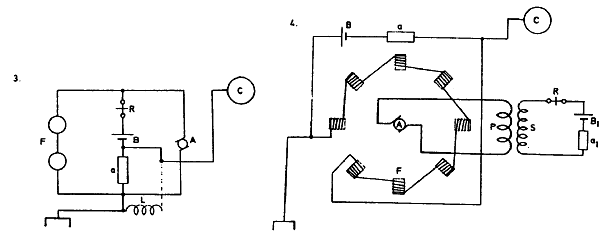
Fig. 4 illustrates one of the dispositions with an alternate and — preferably — high frequency dynamo. The letters are self-explanatory. The
sensitive device a, may be omitted.
Colorado Springs
July 16, 1899
In order to produce the greatest possible movement of electricity through a region of the earth in accordance with the plan involving use of a single terminal oscillator, as here experimented
with, it is desirable to obtain in some way a large capacity on the free terminal. This is connected with difficulty as spheres get to be too large with moderate tensions and when the tensions go
into the millions, streamers can not be easily overcome. The streamers involve loss of pressure just as leaks would on a water pipe which is closed at one end. Large capacity is obtainable in a
number of ways of which some are:
1) a coil wound for maximum capacity (internal). The turns are so disposed that between the adjacent turns of layers there exists a great difference of potential, as much as the insulation can
stand.
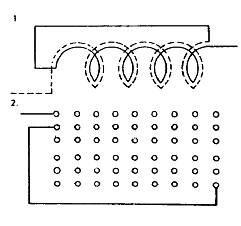
This is best done by following plan illustrated in Fig. 1 in which there exists between each two turns one half of the total difference of
pressure which is active on the terminals of the coil. But other arrangements may be followed as, for instance, illustrated in Fig. 2, or similar dispositions may be made so that there shall be
the greatest possible difference of pressure between the adjacent layers. Or the capacity may be increased by a conducting coating over the insulation of the wire, which coating may be connected
suitably so to secure the maximum storage of energy in the coil;
2) A valuable way of providing capacity is to employ a vessel in which the gas is more or less rarefied. The electrodes leading in should be of wire gauze and present a large surface but
throughout of small radius of curvature. Such a way of obtaining large capacity Lfind very good in telegraphy in connection with receivers and their circuits. Hydrogen seems to be better than
other gases to employ in the rarefied vessel.
3) Capacity may be also provided by storage batteries or voltameters or liquid condensers.
4) Another way is by local condensers arranged on end of wire near the free terminal. This is illustrated in annexed diagrams.
In Fig. 1. and 2. two of the many arrangements are shown. In Fig. 1. a condenser is placed at the free end of the secondary S of the oscillator, the other end being connected to earth. One coating is directly connected to the end of the secondary, that is to b, the other coating to a point a which has a suitable difference of potential with respect to b. By the operation of the oscillator energy is stored in the condenser C, which energy must all be supplied through the secondary, thus producing a large movement in and out of the earth.
A modified arrangement is shown in Diagram 2.
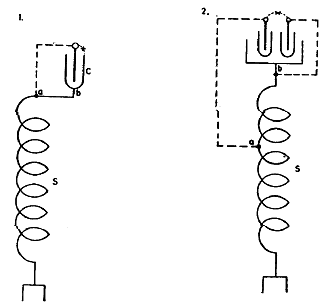
An arc may be maintained on the places marked x. Proper rules of tuning are observed to secure best result.
Colorado Springs
July 17, 1899
Some arrangements of apparatus experimented with. Modifications of former plans.
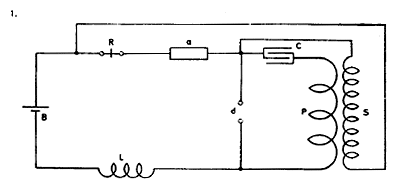
Here relay is placed in series with sensitive device but in secondary. In this way slay is not affected by break. The charge of condenser may be regulated by varying L r by resistances in series with L or with S.
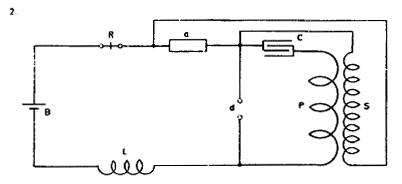
The relay is affected by the break in this disposition but the action was good in some instances; probably secondary S was more effective in breaking through the sensitive device a.

This disposition is simple and secures good results but one disadvantage has been found in the short circuit of the secondary through the
condenser, which is necessarily too large for the high tension secondary since it fits the primary P. The above defect is reduced largely by the introduction of regulable self-induction L, or
similarly a resistance is used instead of L. In all these dispositions of apparatus the effect upon the sensitive device is rendered accumulative.
Colorado Springs
July 18, 1899
Other arrangements of apparatus experimented with.
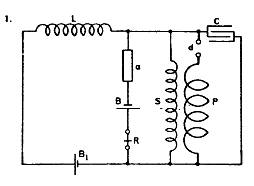
In this scheme the excitation of the condenser and therefore also of the sensitive device a was regulated by an adjustable self-induction and additional battery Bv The battery B can be in the same or opposite direction working through the device a. The former was apparently preferable.

Of these two connections the first was advantageous as the battery was not working except when the sensitive device was excited.
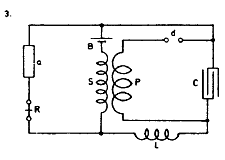
This was a plan (3) similar to one previously experimented with, only the battery B was placed so as to be able to charge the condenser.
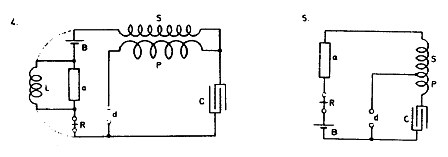
To determine excitation of sensitive device to the point of breaking down a self-induction coil L (very high) was placed around it (4). This
coil was also tried with connections changed as indicated by dotted lines.
Here again (5) a part of secondary was used as primary. The arrangement worked well probably because as in some instances previously the secondary was open and the rise of pressure considerable
upon a small excitation of device a. This is suitable for a device of great resistance.
Colorado Springs
July 19, 1899
Some simple dispositions in the practical uses of apparatus as now available.
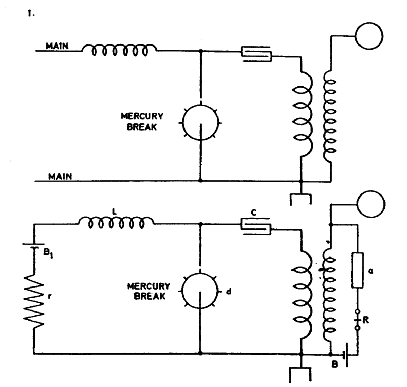
The connections in the oscillator as now manufactured are as shown in first sketch. In this way the apparatus is used as a sender. The connections are now by a throw of a switch changed in such a way that all can be used in receiving the message. One of the simplest connections is shown in the following sketch.
The relay R should have small self-induction. By battery B1 the excitation of device a is regulated. For facility of adjustment a resistance r is also inserted. The switch is to be worked out in detail.
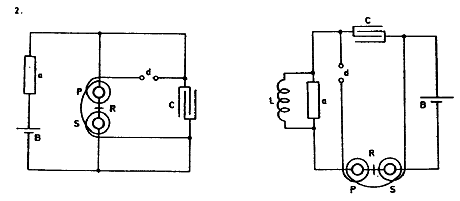
In using the method of exciting the device a by means of oscillating transformer the construction of a special apparatus may be obviated by
winding the primary directly upon the relay so that the relay itself is the transformer. This is schematically indicated in the sketches in which the letters indicate the same. In the first the
battery should be an open circuit, in the latter a closed circuit type.
Colorado Springs
July 20, 1899
Galvanometer from Colorado College set up on lead plate and four rubber supports. Lead plate 50 lbs. Resistance roughly 2530 ohms. The filament is very short, vibration quick, altogether not best
quality but possible suitable for approximate determinations of ratios and resistance measurement etc.
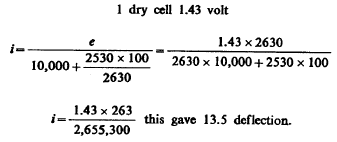

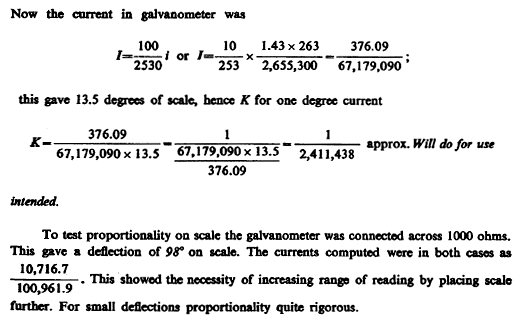
Colorado Springs
July 21, 1899
Various arrangements with two sensitive devices for the purpose of increasing efficiency of receivers in telegraphy. Also for directing currents.
Two sensitive devices, disposed as indicated and so constituted that they break down or respond easier to impulses of one direction than to those of the other, allow the commutation of
alternating currents. For this purpose a device may be employed, described before, consisting of a glass tube and two metallic plugs, the glass tube being about half filled with nickel chips or
fillings of other metal. In Fig. 1. it is supposed that the devices a ax have this quality which may be given, for instance, by a battery in each circuit as shown in Fig. 2.
In both sketches 1) and 2) a relay R R is shown having one of its legs in one of the circuits and the other leg or coil in the second circuit. In this manner the impulses coming, for instance, from a distance as in telegraphy can be made to exercise an accumulative effect. The alternating impulses are led in through terminals 11.
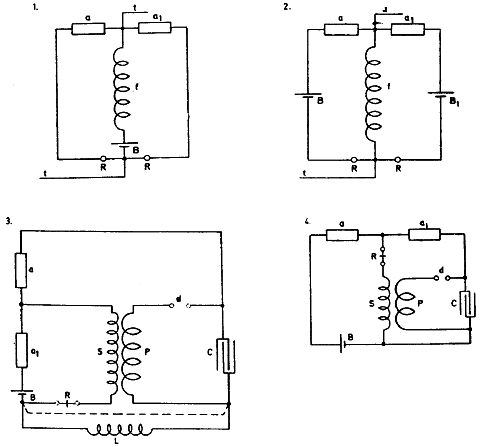
Fig. 3. illustrates one of the connections of apparatus experimented with with good success. The method of excitation and magnification by means
of an oscillating transformer is used and the relay and secondary were connected either as shown in the plain lines or in the modification indicated by the Botted lines. The letters have the same
meaning as in previous instances. In Diagram 4. similar connections are shown, merely the self-induction coil L has been done away with and secondary S adjusted accordingly.
Figs. 5.—8- show again modified dispositions. Fig. 5.: the condenser is in the bridge and the legs of the receiver are placed one in each of the two circuits. In Fig. 6. the condenser is placed
around a battery which is graduated by a resistance (not shown) so that the secondary 5 strains the devices a a\ to the point desired. Fig. 7. shows a similar plan with the secondary in shunt to
one of the sensitive devices and in Fig. 8. two sensitive devices one in one and the other in the second circuit of which each contains a condenser and its own primary.
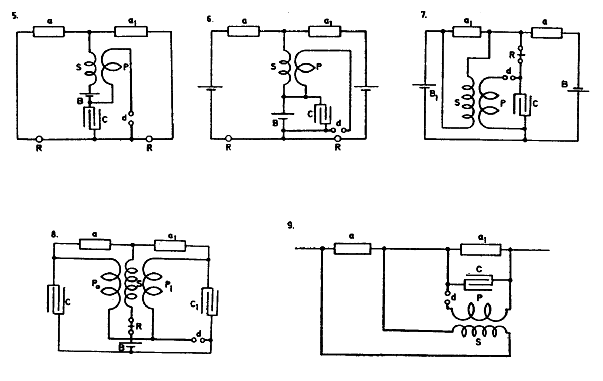
Fig. 9. shows a plan followed in numerous variations and which is capable of excellent results.

Fig. 10. again shows a form of connections which works extremely well. It is suitable for use in connection with single terminal oscillators.
The capacity or elevated terminal may be at C and also at C\. Both cases result good.
Colorado Springs
July 22, 1899
Further modes of connecting apparatus with two sensitive devices for telegraphy and such purposes. A connection as in sketch showed quite satisfactory results. The sensitiveness was probably due
to the fact that the secondary was open as in a previous instance. Several plans of working with two or more devices in multiple were experimented with.

The idea was to introduce greater regularity and reduce resistance of the path through the sensitive apparatus. Some arrangements worked well, for instance the one illustrated in sketch 2. In 3. both devices a and ax were shunted by a high self-induction L, the inductive and ohmic resistance of which was regulated so that devices a ax would break down at the slightest disturbance.
The results were fair but not better than before obtained with other dispositions. The relay was placed in a number of ways, best results when it was in the secondary S.

In Diagram 4. the same mode of connection was employed, only a battery and relay were placed in the bridge. The employment of the special battery Bt allowed some adjustments to be made not practicable in Diagram 3. Generally, battery Bl was differentially connected with respect to battery B.

Diagram 5. again shows a form of connections slightly modified, two bateries being used in series to strain the sensitive devices aa\. Results
about the same. In Diagram 6. the connections were as previously shown in Diagram 1. only the relay was placed in the secondary S. This worked excellently. In. Fig. 7. the same connections were
retained only a high self-induction was connected around the devices and regulated so that devices were rendered very sensitive.
Fig. 8. shows an arrangement to be used in connection with present oscillator employed as sender. The switching connections are to be simplified. The oscillator with mercury break and its
induction coil work much better than interrupters driven by clockwork and small special coils. Important.

The employment of the mercury break particularly makes the apparatus efficient, probably because of perfect regularity of working which can not
be secured by spring contacts or brushes. The efficiency is also in a measure due to the small resistance of primary circuit because of the large copper section and good mercury contact. It is
highly important that in preceding dispositions of apparatus the break is of high frequency, the condenser large and best insulated and the conversion in coil efficient.
Colorado Springs
July 23, 1899
In investigating the propagation through the media, and more particularly through the ground, of the electrical disturbances produced by the experimental oscillator, as well as those caused by
lightning discharge, to which work a few hours were so far devoted every day, a form of sensitive device used in some experiments in New York was adopted, as the best suitable for these
purposes.
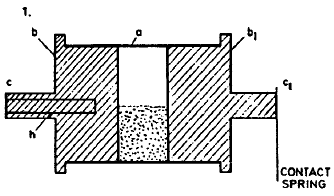
This device, and the manner of preparing it, it is now necessary to describe. In one form it comprised a glass tube 3/8" inside diameter, having two brass plugs fitted in its ends. The plugs had their inner surfaces highly polished and the distance between them was from 1/8"—1/2". The tube is illustrated in Diagram 1. in which a is the glass tube and b b\ the plugs of metal with narrow projections C C\ for support and contact, respectively.
The space between the plugs was filled about 1/3 full with coarse chips of nickel. These chips were made by a milling tool or punch so as to be as much as possible equal in size and shape, this being of considerable importance for the good performance of the instrument. The plug b had a small reamed (tapering) hole h in the center extending to some distance into the plug so as to enable its being placed on a small arbor fitting into the hole and rotated by clockwork at a uniform rate of speed.
In some cases when the working of the device was excellent the speed was 16 revolutions per minute. But often the instrument was rotated very much faster in which case it was merely necessary to increase the e.m.f. of the battery which was used to strain the device to the point of breaking down. A beautiful feature of this kind of device is that by regulating the speed its sensitiveness may be regulated at will and in this respect it is preferable to similar devices which are stationary, the contact after being established being broken by tapping.
The device acts exactly like a cell of selenium, its resistance diminishing when the disturbances reach it, being automatically increased in
consequence of rotation and separation of the chips when the disturbances cease to affect the latter. The rotation of the device replaces here the property of recovery which the selenium
possesses, otherwise the similarity is complete. To insure a quite satisfactory working and permanent state I prepare this form of device in the following manner:
The glass tube, plugs and the chips to be used are first thoroughly cleaned with pure absolute alcohol and dried. Next, one of the plugs, as b, is slipped into one end of the glass tube and the
required amount of chips is put in the other, plug bt being finally inserted closing the tube nearly hermetically, but not quite so. Now the device is placed upon a cylinder of metal with a hole
in the center, to allow the small part of one of the plugs b or b1 to slip in, with some space between, and permit the plug to rest upon and in good contact with the upper surface of
the metal cylinder which is then slowly heated, as by being placed upon an electrical stove or a plate supported above an alcohol lamp.
When the lower plug is brought to the required temperature, sealing wax is run around the rim projecting for this purpose, beyond the glass tube. The metal cylinder is now allowed to cool down slowly until the sealing wax is in some degree solidified when the instrument is turned over and placed with the other plug on the cylinder and the operation of sealing the joint between glass and plug repeated.
During this preparation the chips are of course at an elevated temperature and all moisture is expelled so that, when the instrument is ready, a thoroughly dry atmosphere exists within the same, this being essential for good performance. The atmosphere is, however, at a pressure slightly below that of the surrounding air. When the device is carefully prepared it works remarkably well, and in comparative tests showed itself superior to this kind of device of the form ordinarily advocated.
During a few days I carried on tests of this kind which brought out the good qualities of this kind of instrument. In one instance two of them were compared with a third device of the ordinary form in which the sensitive grains were immersed in an atmosphere considerably rarefied and contact was broken with a tapper.
In all three instruments the grains of nickel were of the same size and shape. One of the terminals of each of the devices was connected to a ground wire, while the other terminals were each joined to a piece of wire extending to a small height, these pieces of wire being the same in all particulars.
All the three devices were strained as far as was practicable by batteries so as to be at the point of breaking down and sensitive to a high degree. Although the pieces of wire extending into the air were only of a length of a few feet, all the instruments recorded the discharges of lightning up to about 30 miles as the storm moved away. At this point it was found necessary to set the instrument with the "tapper" so that it was still more sensitive when it responded but in an irregular manner, while the other two devices continued to record regularly up to a distance of about fifty miles when the disturbances ceased, probably owing to the cessation of the storm.
I inferred from these experiments, carried on for some time with the view of selecting and adopting the best form of such a device, that when the particles of metal are rotated they are, as it were, suspended in the air and in this condition more susceptible to the influence of the disturbances than when they are kept stationary. It seems, however, that when rotated, the particles are not so liable to stick together and cause irregularity of action such as observable in the ordinary form of such a device.
As to the amount of chips, if more are put in the instrument must be rotated at a higher speed or else the battery straining the dielectric must be weaker. Through this kind of instrument much stronger currents can be passed without damaging it and making it further unfit for work.
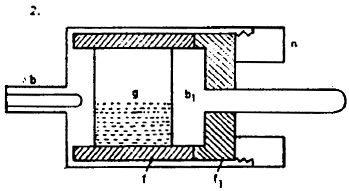
Another form of such instrument particularly suitable for experimentation is illustrated in Diagram 2. It consisted of a brass plug b with a fiber tube into which was fitted another brass or metal plug bi which was held in place by a fiber washer/j and metal nut n. In other devices of similar construction the space between the plugs was adjustable. This form of instrument was particularly suitable for testing the properties of sensitive grains g.
Before testing the grains and the instrument as well were thoroughly dried. To get an idea of the resistance of such devices when in either
state, excited or not, the resistance of many was measured under varying conditions. A fair idea is conveyed by saying that, unexcited, they measured more than 1,000,000 ohms while the resistance
would sink down to 300 or even 50 ohms or still less when excited. When highly sensitive they would respond to sound waves at a considerable distance.
Experiments with oscillator 35 turns in secondary on tapering frame No. 10 - B. & S. wire.
This is the first test of the Westinghouse transformer installed a few days ago. It was tried yesterday evening but only for a short time to merely get an idea how it will behave. The e.m.f. used
was 7500 volts or less. Today a pressure of 15,000 volts on the secondary was used. Best resonating action was obtained with one primary turn and a few turns in the regulating coil.
The spark gaps were as long as obtainable in the box, that is, about 7 turns of the screw on each side, possibly an inch or so. An approximate
estimate places the primary inductances at 75.000 cm. or Lp= 75/106 H. The primary capacity was 88 jars in each of the sets in series. The capacity of one jar being
approximately 0.0035 mfd.
The total capacity Cp is=0.154 mfd. From this calculated, and neglecting as in most cases before the reaction of the secondary, we get T= 214/107 or n=46,730 per second.
Observations: A spark gap being established between the free terminal of the secondary and an earthed wire, strong streamers were seen on the latter. This shows very rigorous action and
demonstrates that the potential of the neighbouring parts of the ground must be considerably affected. Very strong sparks on lightning arresters as the secondary discharge is playing over the
gap. This is certainly extraordinary as the ground is now excellent on trie secondary.
The arc, horizontally passing about 32" long is very powerful, thick and giving a vivid light, the noise is deafening. The arc passes sometimes on a downward course. Is, it attraction or due to surgings of the air in consequence of violent explosions? When large balls 30" diam. are placed in the gap the spark length is nevertheless small. This shows the secondary can not supply the great amount of energy necessary for charging the large balls to full pressure.
This may be due simply to the imperfect inductive connection with the primary or to the small amount of power now available from the supply transformers, as there are only two of them, and the Westinghouse transformer works only at 1 /4 of the normal pressure. This would mean roughly 1 /16 of its total performance. On some points of the balls small streamers are observed; must be due to roughness or points on the places.
The balls will have to be gone over and all the surface polished up. It would be impossible for streamers to break out from balls of such size unless the pressure is a few millions of volts, which cannot be the case at present. A curious feature is to see the sparks deviate and follow wooden beams or planks placed nearby. I rather think this is merely due to an effect of the currents of air which are prevented from circulating freely on the side of the plank or beam.
The intensity of the vibration in the primary is evidenced by sparks passing between the turns of the regulating self-induction coil in the primary. Between the beginning and end of the coil, although only a few of the turns are inserted, the sparks are sometimes 3" long. This shows a very high e.m.f. on the primary and I almost think there must be a mistake as to the pitch estimated which, judging from these sparks, would seen to be much higher.
This is to be investigated closer. Experimentation shows that it is very decidedly better to adopt one turn of primary instead of two and if a lower frequency is desired rather to increase the primary capacity. With one turn the explosions are more violent and the regulation is much more convenient. In these experiments the jars do not seem to be much strained, which indicates well.
At times sparks will break through inside of the secondary between the turns and to the ground. The sparks are very strong from small wires attached to the free end of the secondary more so than from thick wires. When a coil was connected to the free secondary end the vibration could not be well established, evidently the coil was "out of tune" and by its capacity and inductance interfered with the free vibration of the secondary.
The sparks went from the gap-box to the ground though the box was well insulated; there is danger of inflaming the building by this or by the secondary sparks following the wooden structure. The experiments were continued with 7500 volts as yesterday but the working was unsatisfactory. This showed finally that yesterday one of the jars in one set was bad and there was only one set acting, the other set being short circuited; that is why an e.m.f. of 7500 volts was sufficient yesterday.
The Westinghouse transformer gains in e.m.f. as jars are put on, the maximum rise seems still remote, this argues well for the economy of the transformer. The incandescent lamps are all destroyed in consequence of the intense secondary vibration, the filaments being broken by electrostatic attraction towards the glass. Lamps were spoiled at a distance of 40 feet from the secondary free terminal! This action is likely to give trouble in future experiments. A curious observation is that all horses shy.
It is due to sound or possibly to current action through the ground to which horses are highly sensitive either owing to greater susceptibility of the nerves or perhaps only because of the iron shoe establishing good ground connection. I am not quite certain that the secondary vibration is fundamental although for a lower or higher tone it is too powerful. The external gaps used in some trials seem to improve the action somewhat in rendering the discharges of the primary more sudden. If time should permit the vibration will be investigated by a rotating mirror to be prepared.
Next Page
Colorado Springs
July 24, 1899
Experiments with the secondary 35 turns were continued today. In connection with the secondary an "extra coil" was used. The same was before described having 260 turns on a drum 2 feet in diam.
of cord No. 10. The inductance of the coil as before found was approximately 13,900,000 cm. or 139/104 henry. The coil was connected with the lower end to the free terminal of the
secondary white the upper end was left free, a few feet of wire extending into the air.
Resonance, as evidenced by streamers (maximum) on free end of coil, was obtained exactly as in a previously recorded experiment with 9 jars in each set of the primary condensers, or slightly less, at any rate 8—9 jars caused the largest display of the streamers on the free end. The streamers were only three feet long as the energy from the supply circuit was limited, the intention being to first study the peculiarities and behaviour of the transformers before taking them to their full output.
A simple computation showed that the resonant rise on the free end was chiefly, if not wholly, due to the rise in the coil itself, the free vibration of the secondary being comparatively of small moment. To study the harmonics the capacity in the primary circuit was doubled but the effect, as expected, was very small. Now the capacity in primary was again doubled, it being expected that the streamers would be of considerable power under these conditions. This was the first undertone and it should have been fairly strong.
But singularly nothing to speak of was noted although the adjustments were carefully gone through again and again. It was thought that owing to a very small arc in the primary the oscillation did not readily establish itself but this was not highly probable though such has taken place in experiments which I made before. The arc was necessarily small as the capacity was very large in the primary.
The tuning was very sharp with twice the capacity in primary so that a little variation in the self-induction regulating coil made the streamers change very considerably. I expect that it was sharper still with four times the primary capacity so that, after all, the resonant condition may have been missed. This might have been the case easily as all the variation from no streamers to their maximum would have taken place by going through only one quarter of one turn, and possibly less, of the regulating coil.
This sharpness of tuning noted here and in previous instances in some arrangements again impresses me with the value of such dispositions in telegraphy, when it is of great importance to isolate messages. It seems possible to secure in such or similar ways an almost absolute privacy. The experiments with only two circuits show this sufficiently. Continuing the experiments one of the balls of 30" diameter was connected to the free end of the coil and now the resonating condition was secured with 23 jars on each side of the primary.
Summing up the results the vibration with coil alone, without ball, with 9 jars on each side of primary was, approximately, taking the primary capacity equal to 9/2 x 0.003= 0.027/ 2 = 0.0135 mfd.

and n = 102,460 per sec.
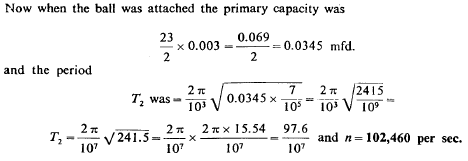
The ball slows the vibration of the coil very much down. From a series of observation with capacities of varying value useful estimates may be
made and the quantities of moment calculated. This mode of proceeding seems to offer features of considerable value in experimentation and it will be followed up. A curious observation in these
experiments was that maximum rise was obtained always with the regulating coil practically all out.
How is this to be explained?
Experiments with the secondary 35 turns were resumed. The probable causes of the curious phenomenon that maximum resonant rise (on the coil attached to the terminal of the secondary, as before
described) took place when the self-induction regulating coil was practically all cut out — were considered.
Evidently when the coil was cut out there was more energy available for the excitation of the primary turn and therefore the secondary was more strongly energized, this giving a higher electromotive force on its terminals. Owing to this the impressed e.m.f. on the coil attached to the free terminal of secondary was greater and therefore the coil was more strongly excited. Assuming then that the secondary free vibration did not take place, this explanation would be acceptable but for one thing: the maximum rise on the coil with 260 turns did not occur, when all the turns of the primary regulating coil were cut out, but at a point when there remained still a few turns in series with the primary.
The phenomenon must be therefore interpreted differently. To all appearances the secondary free vibration did occur, and there was a certain inductance in the primary which gave the highest e.m.f. on the excited coil on the free terminal of secondary. But now the latter was in fairly close inductive relation with the primary hence its own vibration was more or less modified by that of the primary. In altering the primary vibration, that of the secondary must have been, therefore, correspondingly altered.
Now, the secondary excited the coil with 260 turns and, to insure the maximum rise on the free terminal of the coil, the secondary vibration ought to have been of exactly the same pitch as the free vibration of the coil. From this it is plainly seen that if the primary vibration was such as to favour a rise in the secondary of the pressure at the free terminal then the impressed e.m.f. on the coil with 260 turns was greater; but this evidently, judging from the actually observed results, look place when the secondary vibration was "out of tune", more or less with the free vibration of the coil.
Thus it happened that by raising the secondary e.m.f. up to a certain point there was an increased resonant rise on the excited coil. But when, by further cutting out turns of the regulating primary coil, the secondary vibration was modified more and more and brought "out of tune" with the free vibration of the coil excited by the secondary, the resonant rise on the terminals of the excited coil was diminished.
Now, with a certain small number of turns of the regulating coil still included in the primary, the relation between these opposing elements determining the resonant rise was such as to insure the maximum. I have no doubt that this is the correct explanation of the phenomenon observed. At first I thought that the length of the primary might have something to do with it, as I have observed before something to this effect, but now I must reject this view as improbable.
From the preceding it is now quite evident that in cases when the free vibration of the secondary can assert itself, the primary capacity and self-induction has to be such that maximum e.m.f. is obtained on the secondary — then the excited coil must be such as to vibrate in accord with the secondary or (inasmuch as the secondary vibration is affected by the primary) the free vibration of the excited coil must be the same as that of the combined primary and secondary system.
When the vibration in the secondary is exactly the same as the free vibration of the excited coil the maximum rise will be obtained on the coil,
in any event, but for the best result the secondary must also be tuned to the primary so that greatest impressed e.m.f. is secured on the coil.
In cases where the secondary is in such intimate inductive connection with the primary then the latter condition need not be considered and it is only necessary to adjust the coil so that it will
have the same period as the oscillation in the secondary. In fact, I believe this will be, in the end, the best condition in practice for, if the transformer be efficient, the connection between
the primary and secondary must be a very close one. In such a case the high impressed e.m.f. on the excited coil will be obtained only by transformation and not by resonant rise.
A gratifying observation was made today which was the following: the water pipe to which the secondary lower end was connected, and which conveyed the currents to the ground, was disconnected
from the secondary and the latter connected to a separate ground plate at a distance from all other ground connections.
Everything was carefully examined to be quite sure that there was no other ground connection in the secondary. Nevertheless, when the secondary discharge was made to play, strong sparks went continuously over the lightning arresters. There was no other possible way to explain the occurrence of these sparks than to assume that the vibration was propagated through the ground and following the ground wire at another place leaped into the line!
This is certainly extraordinary for it shows more and more clearly that the earth behaves simply as an ordinary conductor and that it will be possible, with powerful apparatus, to produce the stationary waves which I have already observed in the displays of atmospheric electricity. The mere observation of the sparks speaks well for the power of the apparatus used and clearly shows that it is competent to carry to a great distance even as it is when used as a transmitter in telegraphy.
Assume even that the pressure would diminish as the square of the distance from the source, still the performance would be remarkable. Such an assumption seems to be justified when we consider that the density of the current passing over the earth's surface will diminish as the square of the distance from the center of the disturbance and consequently, the effective pressure at least, ought to diminish correspondingly.
Now, in the experiments above described the distance between point a, where the lower end of the secondary was grounded to point b, where the sparks jumped from the ground to the line or vice versa, was 60 feet. Hence on the above assumption we can


Capacity of secondary 35 turns used in preceding experiments.
The average length of one turn may be put at approximately 135.1 feet=4120 cm. The wire is No. 10 B.& S. diam=0.102"=0.26 cm. Surface of wire in sq. cm. =7c x 0.26 X x4120x35=7tx37,500 cm.
approx. The capacity was compared with that of 1/2 mfd. standard condenser and was found to be C=3600 cm. This measurement was I expect correct within 1/2%.
Note: The measurement was made by connecting the cable with one end, or with both ends to the source, the other terminal of which was connected to the earth. Result was the same.
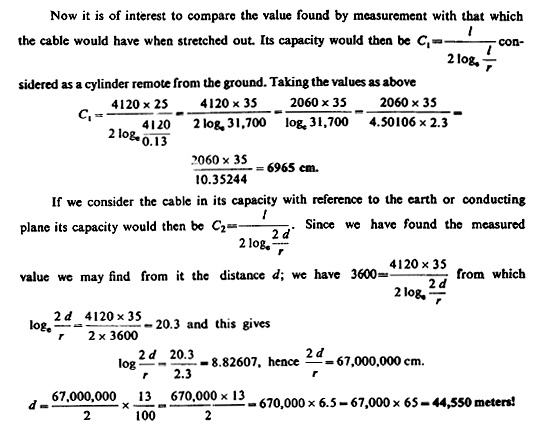
The result only shows that the cable measures much more when straight and at some distance from the ground since d comes out so large.
It may be of further interest to compare the capacity as found with capacities which would be obtained if the surface of the cable were converted into the surface of a disc or sphere, for
instance. Taking first the latter and calling its radius r' we have
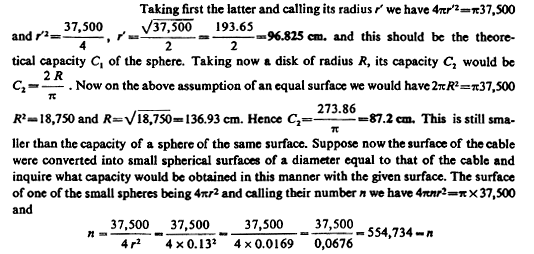
The total capacity C3 of all these small spheres, neglecting mutual screening action, will be n times the capacity of one of the spheres and since the latter is=0.13 we would have total capacity C3=554,734 x 0.13 = 72,115 cm.!
A very large value indeed, which would have been still greater if the diameter of the spheres would have been smaller. These primitive considerations show that to get the largest possible capacity with a given surface we must use the latter in the form of minute surfaces of the smallest possible curvature.
This makes it obvious why exhausted bulbs show under certain conditions such comparatively large capacity. And this explains the virtue of bulbs when used in telegraphy for the purpose of supplanting a large elevated plate or wire leading to a great height. Such a bulb or tube, particularly when filled with hydrogen, is (as I have found) very effective and I look to a valuable use in the future of such rarefied vessels in connection with telegraphy through the media or the like.
The greatest capacity with a given surface will, of course, be obtained with spheres of the smallest possible diameter, as the spheres of hydrogen. The next best form to give to the surface would be a cylinder of great length and minute diameter. The above considerations make it plain why thin wires have such a comparatively large capacity. Taking two such wires of the same length L and diameters S and &x, we would have their capacities as
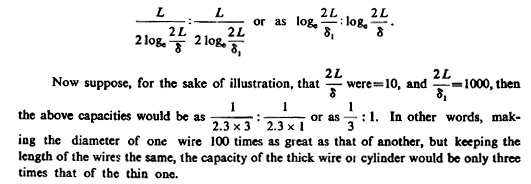
Colorado Springs
July 25, 1899
Experiments with the secondary of 35 turns continued. The secondary was tuned alone and more carefully, the result being that maximum rise of pressure was obtained with one turn of the primary,
the two cables being connected in multiple, and 78 jars on each side of the primary. When best action was obtained there were a few turns in the regulating coil in series with the primary cables,
the total self-induction in the primary being estimated to be Lp=85,000 cm. or 85/106 henry.
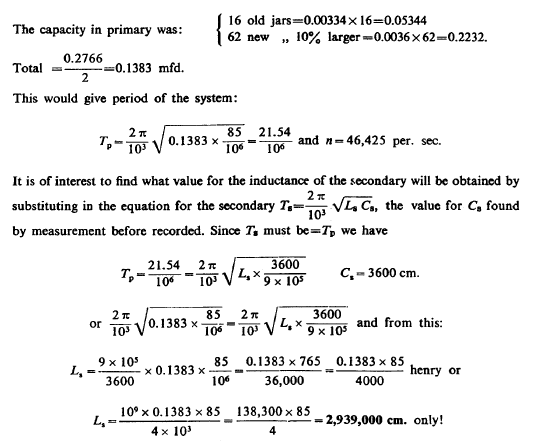
While this estimate is not correct in principle it shows, nevertheless, that the capacity measured in a state of rest is not that which enters
as an element of the vibration. It was thought from this result that the secondary might have responded to the first octave and the two primary cables were joined in series, but results proved
inferior.
It is possible that when the primary cables were connected in series, owing to the less satisfactory working of the spark gap, the e.m.f. on the secondary was smaller than it ought to have been
if both the primary and secondary vibrated at the same rate.
Furthermore, it should be borne in mind that when the cables were in series and the vibration in primary reduced to half the number per second, the induced e.m.f. in the secondary turns could have been only about one half of that in the first experiment. If in the latter experiment with the primaries in series the true note of the secondary was struck then, assuming the capacity to be 3600 cm. or thereabouts, the inductance of the secondary as modified by the primary would have been still only 4x2,939,000=11,765,000 cm.
It is, therefore, probable that the capacity which enters as an element of the secondary vibration is much smaller than that which is found by
measurement, which is as might be expected, since the cable can not be fully charged and discharged at each alternation, as is evident from the constants.
Observations during the experiments today.
When the secondary worked very well the spark was very noisy and nearly an inch thick, judging by the eye, and about 3 feet long. The sparks passed all the time over the lightning arresters as the secondary discharge was playing and, at times, for a short interval they were extremely vivid and thick. This seemed to occur chiefly when the secondary arc became louder and roaring, this indicating a better working of the arc and a higher e.m.f. for a given length of the path through the ground.
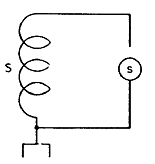
The sparks on the arrester's arc, as is now established beyond any doubt, are due to the propagation to the ground through the earth wire, and it is now plain that although they take place when the oscillation is slow, they are more easily produced with a quicker oscillation. Perhaps the higher harmonics enter prominently into their formation.
The secondary arc was adjusted to a length of 31", then the sparks on the arresters were very violent. It was thought that, if the © vibration was propagated through the earth wire and caused the sparks on the arresters in this way, by adding capacity to the earth wire the action on the arresters would be increased.
Accordingly, a sphere of 12" diam. s was connected to the wire as I shown in diagram and, indeed, the play on the arresters was intensified. By now reducing the gap still a few inches the display on the arresters seemed to increase further. When the secondary discharge was permitted to pass continuously for about 5 minutes the fuse on the supply circuit primary gave way showing that energy was taken at a rate of about 20 H.P.
This also indicated that the connection between the primary and secondary of the oscillator was fairly close and that the secondary was capable
of taking up considerable energy. When two external gaps were used in series, with gaps in box, less energy was taken from the supply circuit, this indicating that the arc in primary
short-circuited the secondary of W.T. to some extent.
Colorado Springs
July 26, 1899
Investigating vibrations of "additional" or "extra coil": from observations before made it would appear, as I believe it has been stated already, that when the impressed electromotive force was
increased, in other words, when the movement in the secondary was made greater, the free vibration of the extra coil did not readily assert itself. At least this has been noted in a number of
experiments with the object of ascertaining this.
A complete analogy is afforded in mechanics. In order that free vibration may take place, and readily, there must be a loose connection with the part impressing the movement. This truth is obvious. Considerations of this kind led to experimentation with an arrangement, as illustrated in the sketch below: In this the connection with the secondary S impressing the movement was loosened, so to speak, by the insertion between it and the coil C to be excited another coil c which was generally adjusted to suit the conditions.

This amounted to the same as increasing the momentum of coil C and rendering it more preponderating and capable of freely asserting itself.
These experiences lead to a rule long recognized, that development of the oscillator must be in two directions: either in the direction of obtaining a high impressed electromotive force by
transformation ratio, when the connection between the secondary and primary is rigid; or obtaining a high e.m.f. by an excited extra coil in loose connection not reacting inductively.
Colorado Springs
July 27, 1899
Experiments were made today with spark gaps constituted as indicated in the sketch below: The idea in this scheme was to make gaps in the box, which varied from a very small to a great length
owing to the movement of the break wheel B, very small and the gaps a and b very large, so large that the discharge could break through only when the gaps in the box were at their minimum
length.
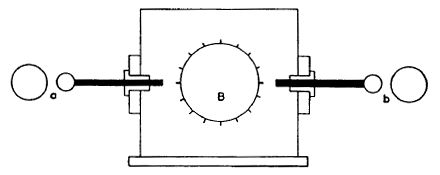
Thus the loss in the box itself was greatly reduced and owing to the great velocity of separation of the electrodes, a greater suddenness of disruption was obtained. This was, of course, certain since the gaps in the box could not be bridged except for a short interval since gaps a and b took up the e.m.f. Thus the velocity of separation was the greater the smaller (in length) the arcs in the box were made.
The adjustment of their length was effected by merely varying the length of gaps a and b. In these experiments spheres of various sizes were used to constitute the additional gaps a and b and it was observed that unless the induction coil be capable of giving a large current, spheres of considerable size were not the best to employ in the usual arrangement of apparatus.
The reason was that the arc was formed with difficulty, hence it had to be made shorter, but when the current broke through, the resistance of the small arc was very low and the secondary of the induction coil was short circuited too much. This may not be always true. By using additional gaps the primary was closed during a shorter interval of time and also the secondary was less short-circuited. The latter was an advantage but the former was decidedly a disadvantage because the primary circuit could not vibrate very long.
The energy taken from the supply transformer or coil was, of course, smaller. All the results obtained in these experiments seem to indicate, contrary to former opinions, that a higher economy is obtainable with one gap that with a greater number. This observation was, however, made before in the New York apparatus.
Finally, two gaps in series were adopted as convenient and giving greater velocity of separation. But the best results were obtained with two electrodes in the form of toothed disks rotated in opposite directions. The apparatus in this form was more troublesome to run but worked decidedly better. In this form also an improvement was practicable, which I have since adopted in some form of mercury breaks, and that was to make the number of teeth on each disk such that the total number of the makes and breaks was the product of both the numbers.
In this form a small number of teeth was found sufficient for a great number of breaks and the arc could not follow from one to an adjacent
tooth.
Colorado Springs
July 28, 1899
The following arrangement was found particularly efficient in applying the method of magnifying the effects of feeble disturbances by means of a condenser. Two instruments were fixed up in the
manner indicated in diagram. A similar plan of connections was used before only the sensitive device A' was differently placed, as it was found to disadvantage.
The sensitive devices A and A' were prepared as described on a previous occasion and showed, unexcited, a resistance of over 1,000,000 ohms, but when excited the resistance fell in both almost exactly to fifty ohms.
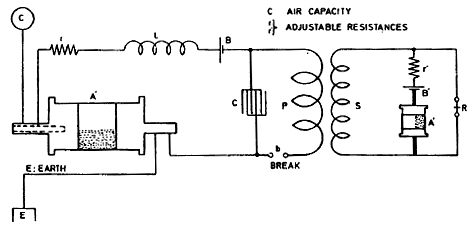
Later, instead of the device A' another was employed of a higher resistance when in the excited state and the coil P S was replaced by one with more turns in the secondary. As finally adopted the secondary S had 160 turns in each layer and 32 layers making 5120 turns.
The relay R had a resistance of 998 ohms, wire No. 36. The primary P had 50 turns of lamp cord No. 20. The self-induction coil L had 1900 turns of wire No. 20. All coils were wound on spools 4" diam., 4" long with wooden core 1 1/4" in center. The condenser C and 1/2 mfd. Battery B: 8 cells 11.1 volts; Battery B': 4 cells about 5.7 volts. Speed of rotation of the devices A and A' was about 24 per minute. The break b was 72 per second.
The break wheel and arbors of devices A A' being driven by clockwork. The break wheel has 180 teeth, a small very thin platinium brush bearing
on it. The devices readily responded when four persons joining hands would shunt the device A'. In one instance the devices recorded effects of lightning discharges fully 500 miles away, judging
from the periodical action of the discharges as the storm moved away.
Colorado Springs
July 29, 1899
As has been observed before, in order that the free vibration of an excited coil may predominate it is necessary to make the momentum of the coil very large relatively to the impressed vibration.
With the object of bettering the conditions favorable for the free vibration, a new coil was wound on same drum 2 feet in diam. and 6 feet long. This coil had, instead of 260 turns as before,
about 500 turns of cord No. 20. Its inductance was therefore nearly 4 times that of the old coil or about 40 million centimeters roughly.
The coil was connected to the free end of the secondary and resonance was observed with 32 jars on each side, there being on each side two tanks in series, so that the total capacity was only 4 jars in the primary. Taking the capacity of one jar at 0.00334 mfd. the total primary capacity was 4x0.00334=0.01336 mfd.

First the Westinghouse transformer was connected to give 15,000 volts, but later it was made to give 22,500 volts. The capacity in the primary was evidently too small for the best working of the transformer and the arc schort-circuited the secondary considerably, this causing a great deal of energy to be drawn from the supply circuit. This is always the case when the primary arc does not work well.
To insure the best working conditions the transformer should first be able to charge the condensers and the rate of energy delivery of the latter into the primary of the oscillator should be just a little greater than the rate of energy supply by the feeding transformer. Then the arc is loud and sharp and there is no short circuit on the secondary of the latter transformer as the currents over the gap are of very high frequency and the low frequency current of supply — or if it be a direct current — can not follow.
The system then works economically and the economy is much greater than might be supposed judging from the unavoidable losses in the arc. As the capacity was too small a flaming arc often formed in the box, a sure sign of bad working, the curious feature being that the arc was of a decidedly red color. This may be due to the alumina which was formed as the break wheel was of aluminium.
As was expected, the use of two additional gaps improved the working of the apparatus, reducing the trouble due to the short-circuiting of the Westinghouse transformer. It was observed that when the gaps were made so large that the arc did not break through, a lamp on the supply circuit near the condensers — about 6 feet from the same — would brighten up. I am not quite sure that this was due to resonant rise in the Westinghouse transformer, for it may have been due simply to electrostatic action from the jars, as I have observed a similar effect before.
When the electrostatic influence is strong the gas in the bulb is excited, the discharge passing through the same though, of course, it is not visible on account of the intense light of the filament. Particles are thrown off and against the carbon and the same is, on the one hand heated to a higher temperature while on the other hand, owing to the hotter environing medium it can not give the heat away so fast as normally — hence it brightens up.
Possibly also a small part of the current of supply passes through the excited gas and slightly more energy is drawn from the mains. It was evident that, as was expected, the free vibration of the coil took place more readily than before when the coil with 260 turns was used, owing to the larger momentum as before explained.
The streamers were larger than with the old coil but not quite so large as it was surmised they would be. Partially because of this fact, and
partially also because not enough energy could be supplied from the Westinghouse transformer to the primary, owing to the small primary capacity, it was decided to change the connection so as to
get the next lower or fundamental tone in the primary, this being in all probability the true note of the coil. The capacity in the primary was made 32 jars on each side in multiple, making the
total capacity 16x0.00334=0.05284 mfd.
The primary vibration was now just an octave lower than before but the results proved inferior to those first obtained. There was now only one thing possible and that is, that the tone was right
after all, in the first experiment, but the results were not quite satisfactory because the primary capacity was too small, thus unfavorable for the best working of the Westinghouse
transformer.
Accordingly, the same vibration was again secured in the primary but this time by using a capacity four times larger and reducing the inductance to one fourth, which was done by putting the two primaries in multiple. Now, indeed, the results were satisfactory, for the Westinghouse transformer could supply much more energy, practically four times as much as before.
The streamers were now much stronger, extending to a distance of 6 1/2 feet from the top of the coil and they were abundant and thick. I can not understand why they should be of such a deeply red color. Those in New York never were such. Perhaps it is due to the smaller atmospheric pressure in this locality. Their movement, and darting about is also much quicker and more explosion like.
At times a big cluster of them would form and spatter irregularly in all directions. Sometimes it appeared as if a ball would form above the
coil, but this may have been only an optical effect caused by many streamers passing from various points in different directions. Many times sparks passed from the top of the coil to the point
where the lower end of the coil was connected to the secondary "free" terminal. These sparks were 8'—9' long.
New condensers proposed: old ones being inadequate to stand the strain beyond 15,000 volts on two dielectrics, it would be necessary to resort to four sets when using higher pressure and this
would make condenser boxes too bulky. It is now proposed to use new bottles of lead glass (Bethesda Mineral Water). These are, as nearly as can be ascertained, twice or rather more than twice
thicker than the old bottles.
The comparison of capacities was made today for this purpose. The new bottles were filled up to 10" from the bottom and immersed in a tin tank. The old bottles were filled up to 9" from the bottom and immersed in a tank. A solution was prepared from rock salt as concentrated as practicable and care was taken that the liquid was at equal height outside and inside. The readings were:
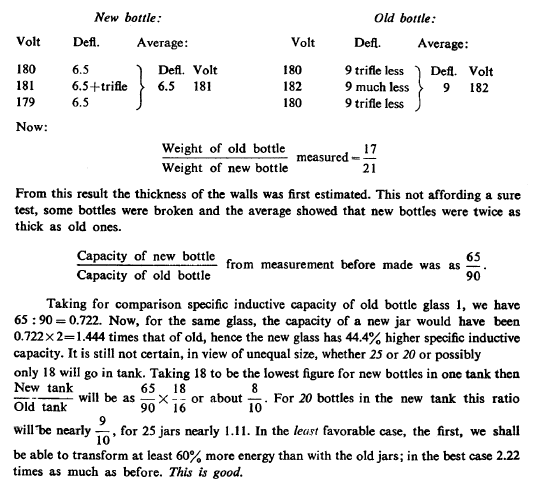
Colorado Springs
July 30, 1899
Further observations in experiments with coil 500 turns before described. In these experiments two external gaps were used in addition to the gaps in the box, all being in series so that the
total length of the spark gap varied from 2 1/8" minimum to about 5" maximum. The two outside gaps were of a fixed length, l" each, while the gaps in the spark box varied rhythmically with the
rotation of the disk. The coil was connected as shown in Diagram 1. to the free end of the secondary, the lowest points of the coil being about 6 feet from the ground.
Resonance was obtained with 7 tanks of capacity on each side of the primary. As it was thought that the tanks might perceptibly differ in capacity Diagram 2. is added showing their position. The primary capacity total was from approx. 0.04336 — 0.0498 mfd., according to connections. The effects observed were in many ways interesting. The streamers produced on top of the coil were generally seven feet and sometimes eight feet long, thick and violently darting about.
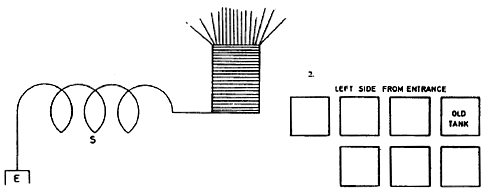
They did not seem so red as those produced before under similar conditions. Very often strong brilliant sparks would pass from top to bottom of the coil. The remarkable feature of the sparks was that they would go in a curve, almost a semicircle, as if they would start out originally in another direction and then be deflected to the lower end of the coil.
Certainly they could have reached the lower end by a route shorter by 40 or 50%. During the display it was observed that no sparks passed over the lightning arresters. This was an indication that only a comparatively small electromotive force per unit length of ground was set up, too small to bridge the gaps on the arresters. In order to see whether the coil would respond to the next fundamental tone the primary cables were joined in series, this making the frequency of the primary oscillations just one half. The coil did respond but the effect was, as anticipated, small, about one quarter.
Presently one of the large balls, 30" diam, with a wire of some 20 feet was connected to the top end of the coil. The self-induction coil being adjusted, very strong streamers were now obtained showing that the ball had reduced the period of the coil considerably. But the vibration of the coil with the ball was still too fast for the primary and another ball, 30" diam. was connected in multiple with the first. By again adjusting the regulating coil good resonating action was obtained.
The sparks and streamers were now stronger, the former passing sometimes to the top of the secondary, a distance of
about 8 1 /2 feet in a straight line. But owing to their curved path the sparks were actually much longer. The sparks passed sometimes also to the ground from a kink in the wire connected the top
of the coif with the balls, the distance of these sparks in a straight line was 103".
The sparks were much fuller, thicker and louder with the balls then without them, they were particularly strong and bright when passing from top to bottom of the coil. It was plain that much longer sparks could be obtained with more turns in the extra coil as then the capacity on the end could be reduced. But the experiments also showed that the amount of electrical movement in the coil was not very great owing to the small section of the wire, for when an arc was established between two large balls it ceased to pass as soon as they were separated a distance of about 1 foot.
The streamers were visible and sometimes strong on the wires leading to the balls' and particularly on the wire leading from the top of the coil but still the sparks failed to bridge the gap. This showed that there was not enough energy available to charge the balls to a sufficiently high potential while, of course, the passage of the sparks was rendered more difficult owing to the large radius of the curvature.
The density ought to be inversely as the radius of the curvature, hence the density on the wire leading to the ball is much greater than on the
ball itself, in other words, which really means the same, the ball is charged to a lower potential than the wire. This seems to me a somewhat novel view to take. Without much thought I would at
once assume that the pressure on the ball and on the wire is the same, but it must be greater on the wire since it can leak out from the same while it does not from the ball.
The thin wire, or any projection or surface of small curvature becomes thus equivalent to a small hole or leak in a pipe or reservoir containing a fluid under pressure and it is plain that such
surfaces of small curvature will greatly diminish the maximum pressure obtainable in an oscillating circuit. It is very important, as I have often noted, in order to insure the high efficiency of
the apparatus, to make provisions for overcoming the formation of the streamers and to this subject a great deal of attention has been already devoted.
In signalling to a distance, the formation of a streamer on the transmitter impairs very materially its effectiveness so that the signals sometimes do not go more than a quarter of the distance or even less just on this account. By using a body of considerable surface, which should be spherical or a cylinder with hemispherical ends better results are obtained than with a wire leading to a height alone, not so much because of the increased capacity, but generally only because there is less opportunity for a leak and the system is more economical in producing an electrical vibration in the ground.
A large sphere or surface, provided it is not too large as to interfere with the vibration of the transmitting system is better than a small one
for the same reasons.
I have, however, observed long ago in this connection that when the transmitting system is formed by conductors of a considerable mass of metal a greater suddenness, or a greater rate of
variation per unit time is obtained and the transmitter is more effective in producing disturbances at a distance.
One obvious cause of this is that usually in such a case pL/R is larger than if the conductors are not of great mass, but as far as I have been able to judge, the chief reason is that an electromotive force, acting upon a circuit so constituted, must give rise to a much greater current, in the first moment when in any manner, as by the passage of a spark, a great and very sudden variation in the electromotive force acting in the system is produced. I make a distinction between these two effects. One raises the pressure gradually, the other is responsible for the great suddenness.
Thus, a mass of metal of minute electrical resistance behaves towards a sudden manifestation of electrical pressure much in the same manner as a
mass of metal of great inertia behaves towards a sudden pressure caused by a blow. In both cases there is an increase of the pressure or force. When in the experiments, presently described, a
small wire was attached to one of the balls, the other ball being left as before, the sparks passed readily between them at a distance of 6 1/2—7 feet.
Nevertheless although the sparks were very brilliant and to all appearance highly effective, no sparks very visible on the arresters when the discharge was playing. Evidently, the electromotive
force developed per unit length of ground was small despite the power of the sparks. Upon thinking over the causes of the absence of the sparks on the arresters, it was soon recognized that in
the connection as used only a comparatively slow vibration was transmitted upon the ground, the secondary effectively preventing the upper harmonics, which would have been competent to produce
the sparks, from passing through the ground.
The connection as first used, which is illustrated in Diagram 3. was now changed into the one shown in Diagram 4.
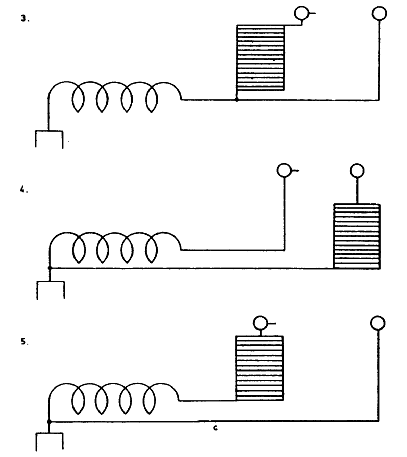
Although the coil was now excited by a small impressed e.m.f. the sparks between the balls were nevertheless quite strong reaching more than 2 1/2 feet. This showed that there was also an induced e.m.f. cooperating with the impressed e.m.f. in the coil to bring about the great rise. Diagram 4. suggested the connecting of the lower end of the excited coil to any other point of the secondary thus regulating the impressed e.m.f. at will.
Again, in the connection as shown in Diagram 4., there were no sparks on the arresters, for the reason pointed out. But when the connection
illustrated in Diagram 5. was made, they appeared and became stronger when conductor c was constituted by a very heavy cable. This was to be expected from the above. It demonstrated the obvious
fact that short waves are more effective giving higher e.m.f. per unit of length in the ground.
New induction coil for apparatus involving method of magnifying the effects by means of a condenser designed for the purpose of investigating: the propagation of waves through the ground and
telegraphy.
A quick vibrating system was constituted comprising a ball of 30" diam. and a stout cable. The period of vibration of this system was found to be, by resonance method, 240,000 per second. It was
excited by sparks passing through a gap of about 7 feet, or less, from a wire connected to the top end of a coil excited by the secondary as last described. It was hoped that stationary waves
might be produced by this apparatus as it seemed powerful enough.
It was desirable to have an induction coil the secondary system of which would vibrate with the same period if possible, and a coil was wound on spool the dimensions of which are indicated in diagram. Now the system being 240,000=/!, this gives the wave length

or 2000 feet approx. The average length of one secondary turn is a little over 4.5", this will therefore require a little over 5000 turns. Now it is desired to use the 1 /2 mfd. condenser on hand for the primary of the coil. The primary must have the same period, hence we have to find the inductance of primary

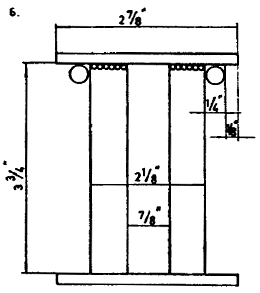

Note: It will be better, of course, to adopt plan used in New York and design coil with a lot of cooper.
Observations of resonant rise on Westinghouse transformer.
In order to observe the rise, the spark gap ordinarily used was made so large that the secondary discharge could not break through and the voltage on the primary, when throwing in the switch, was
observed. Several values of primary capacity were experimented with. The diagram below indicates the position of the set of condensers on the right side looked at from the center of the building
towards the entrance.
On each side of the primary there were then 2 sets in series, the connections in one instance being indicated in diagram. In each old tank there
were 16 jars, 7. the capacity of each jar being 0.00334mfd. In each new tank there were 16 jars, capacity of each jar 10% more, being 0.00367 mfd.
With tanks a and b off we have, calling C1 total capacity:
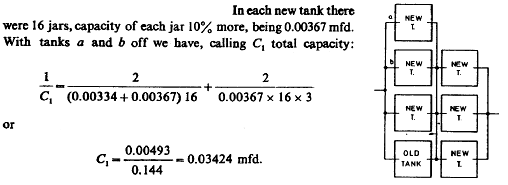
With this capacity on the secondary of the Westinghouse transformer the rise on the primary, as observed by Weston voltmeter, was from 102 to 122 volts. With tank b on each side added, the total capacity being C2, we have:

and from this C2=*0.04336 mfd. In this case the rise was from 102 to 126 volts. With tank a still added on each side to the preceding, the value C3 of capacity in the secondary was 0.0498 mfd.
and the rise in this instance was from 102 to 130 volts.
Note: In all cases when the switch was thrown in, the pressure rose higher at first and then settled down to the values recorded which are once more given in the results summed up:
Results:

Colorado Springs
July 31, 1899
Proposed condenser from Mant ion Water quart bottles
Comparative test with sample bottles showed as follows:

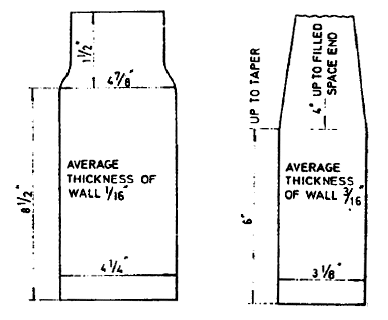
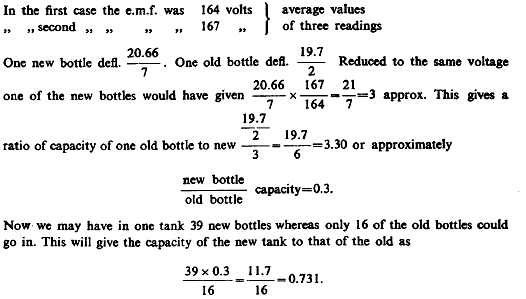
Now mean diam. of cylindrical part of old jar outside =4.5625". Now mean diam. of cylindrical new bottle jar outside=3.125". Allowance for upper
part on old jar 1 1/2" taken of same diam. as cylindrical or nearly cylindrical part.
These figures would give:
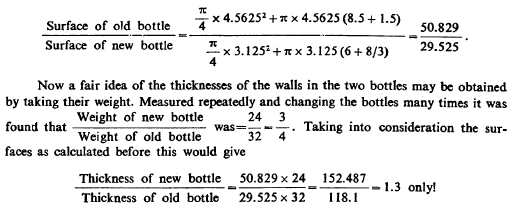
Since the thickness ratio is much greater as found in this way the determination of the thickness by weight as above is not practicable without making allowances. The glass is evidently uneven, much more so in the old bottles than in the new. In the former particularly the bottom is heavy which vitiates the result inferred from the weight of the bottles.
Many bottles were broken and it was ascertained that the average thickness of new bottles was three times that of the old. It was quite certain at any rate, that the weakest spot on the new bottle was fully three times the thickness of the weakest spot on the old.
This was the most important thing to ascertain for the bottles give way at the weakest place. Now since the capacity of the old bottle in relation to that of the new is found by measurement to be 1 : 0.3 approx. and the surfaces are as 50.829/29.525 we can get an idea of the specific inductive capacity of the latter with respect to that of the former.
The new bottle would have for the same thickness, that is one third of the actual, 0.9 instead of 0.3 and for the same surface it would have
50.829/29.525xO.9 or 1.55 times the capacity of the old, both things considered so that the specific inductive capacity of the glass in the new bottle must be something like 55% greater than that
of the glass in the old bottle.
Vichy water syphon bottles tested with the object of using them in the proposed new condensers. Dimensions: 3.8" outside diam. The glass is from 1/4" to 1/4"+1/64" thick, very uniform.
Height available 6 1/2" Mean diam.

The capacities are in this ratio and the test shows that, while the Vichy bottles would make excellent condensers, the capacity for two sets in series as desired would be too small. The reason is that the wall is unnecessarily thick. If it were convenient to use only one set of condensers nothing better could be desired. It having been practically decided to adopt the Maniton bottles, tests were made to see how much pressure these bottles would stand safely.
Accordingly 7 of these bottles with wall rather weaker than normal, hardly 1/8" thick, were placed in a tank with the other bottles. The concentrated salt solution reached to a point about 3" from the top. Paraffin oil was poured to nearly the top. First 7500 volts were turned on, then the tension was raised up to 15,000 volts and the bottles withstood. The e.m.f. was then raised to 22,500 volts when the bottles began to give way, three being broken after some time.
The conclusion was that two sets of bottles in series would withstand quite safely at least 30,000 volts. The glass is really excellent. These
tests were made with 144 cycles per second. A curious observation was that when one bottle gave way others followed, this being due to the violent oscillations caused or else to the concussion
upon explosion.
Approximate determination of secondary modified in construction for the purpose of overcoming the drawbacks of distributed capacity.
As before remarked, on a number of occasions, one of the chief difficulties encountered in the operation of a large oscillator is the distributed capacity, owing to which the efficiency of the
machine — in transmitting an electrical movement to the environing media — is greatly impaired. The distributed capacity becomes particularly hurtful when the turns, are of large diameter or
when, generally stated, there is a great difference of potential between portions of the wire not far apart.
The adjacent portion of the wire acts like a condenser in which energy is stored at each alternation, and the amount of this stored energy is proportionate to the square of the difference of potential existing between the portions of the wire constituting the condenser. Now most of this movement of electricity, occasioned by this distributed capacity, takes place within the coil and does not, unless in a very small part, appear in the external circuit.
Since the movement in the latter circuit is the chief object, the charging and discharging of the condensers formed by the turns of the coil is
mostly lost for the purpose for which the machine is designed. In a properly designed oscillator of this kind all the movement produced in the coil should be propagated to the external circuit,
but this condition can never be rigorously realized.
The object of the design which will be presently considered is to approach this degree of perfection as nearly as practicable. Referring to Diagram 1. illustrating a second*™ city" from E into C
and vice versa, it will be seen that the succeeding turns form small condensers c, c, c, in which a local movement takes place which is not transmitted through the entire wire.
Such a coil S with considerable distributed capacity will, therefore, not be efficient in producing disturbances such as I contemplate using for a number of purposes. The distributed capacity is particularly hurtful when it is desired to produce a very high potential at C and, as this is generally the case, it is important to adopt a construction and observe working conditions such as will reduce the evil to the minimum.
I have in similar instances attained the object more or less by constructing a secondary in parts connected in series through condensers, and' a secondary to suit the present apparatus designed on this plan is now to be considered. In order to explain better how such condensers in series act in reducing the effect of distributed capacity, as pointed out before, reference is made to Diagram 2. which shows turns or portions of the secondary connected through condensers c, c, c.
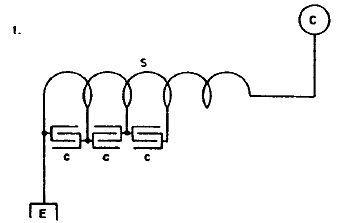
Suppose there would be n such parts as t joined in series and let C, be the total capacity of the coil or secondary S, then the capacity of the turns or portion / would be —.
But now, if there be on the ends of this portion t condensers n C, and C2 it is plain that the distribution of electricity along the portion t will be greatly modified by the presence of these condensers and, if their capacity be very much greater than that of the wire f, almost all of the electricity will reside on the coatings of the condensers, hence there will be very little local action in the portion t, and most of the electrical movement created in the wire will be transmitted along the entire length of the same from E to C and vice versa.
The machine will then act more efficiently and will be much more suitable for the transmission of energy through the terminals E and C for whatever purpose the energy be intended and in whatever manner it be used. It should be stated that in the particular form of oscillator as here illustrated, the lower turns of portions which are closer to the earth, and therefore at a lower potential, are not nearly as hurtful as the upper ones, or to put it more generally, those which are farther away from the earth connection and closer to the free terminal.
The latter are, namely, at a much higher potential and there exists generally a greater difference of potential between portions of wire of the same length when the resonant rise is considerable; as the energy stored in the distributed condensers is proportionate, as before stated, to the square of the difference of the pressure between adjacent portions, it is, as a rule, of advantage to make the upper turns of smaller diameter or to put them farther apart.
But in certain instances this very drawback can be turned into an advantage and by placing a few of the turns near terminal C
as close together as practicable a greater electrical movement may be produced in the lower turns or those nearer to the earth connection and the effect exerted at distance may thus be increased,
though I prefer not to resort to this means as a better result is obtainable in other ways.
Coming now to the consideration of the secondary to be modified in the manner proposed let Diagram 3. illustrate the arrangement as contemplated in the present instance, a condenser C being placed between each succeeding turn of secondary S.
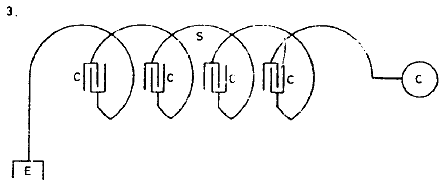
I shall make a rough estimate on the basis of one primary turn and the maximum primary capacity available, which is 80 jars on each side giving a total capacity of 40 jars or 40 x 0.0036= =0.144 mfd. approx,, there being two sets in series. This would give n=50,000 per second roughly.
Assume we work with 30,000 volts from the Westinghouse transformer and retain, as at present, 35 turns of the secondary. In this case, considering the distance of the secondary turns and their decreasing diameter, the induced e.m.f. in the secondary will be much smaller than might be inferred from the ratio of transformation which will be 35 :1 ; with reference to measurements of mutual inductance made before, with a secondary wound on the same frame, it may be estimated at 18 times the primary e.m.f., that is, the induced e.m.f. in the secondary may be assumed to be 18x30,000=500,000 volts nearly.
Taking the number of breaks at 1200 per second as used in some of the preceding experiments with the apparatus, and assuming the charge of condensers always effected at an average pressure, say 6/10 of 30,000 or 18,000 volts, the energy stored in the condensers per second and delivered in the primary will be
 x 1200 watts or 28,000
watts,
x 1200 watts or 28,000
watts,
that is nearly 38 H.P. will be taken by the apparatus under these conditions. This is, of course, only an approximate estimate. We may now, on
this basis, estimate the current through the Westinghouse transformer's secondary, which will be roughly estimated  = of an ampere, or with losses etc., say one 30,000 300 ampere. The performance will thus be still
much below the maximum output of the trans-
= of an ampere, or with losses etc., say one 30,000 300 ampere. The performance will thus be still
much below the maximum output of the trans-
Tormer as it can deliver 1 amp. at 60,000 volts pressure and continuously and, I have no doubt, much more, as so far not the slightest increase of temperature has been noted after prolonged
working. Assume then the current through the supply secondary to be one ampere, the current through the primary of the oscillator will be increased by the factor Lp/R approx. Here
L=7/105 and p=6n, roughly=3x 105.
R is difficult to estimate since the primary circuit includes the arc over the spark gap. I have adopted a method for determining the resistance of the arc with fair accuracy and this will be the subject of a later consideration. The resistance of the Primary cables in multiple is entirely negligible, there being in each 37 wires, No. 9. Taking 1265 feet per ohm, the resistance of about 160 feet of such two cables would be

While, of course, such a condition can not be realized in practice we may approach this value more or less by doing away with the arc in the primary as, for instance, in the form of an oscillator with mercury breaks, which I have devised to work with low tension so that the arc practically does not occur.
Or a condenser may be placed in shunt to the primary as has been already considered on a previous occasion. By experience I know that the initial currents in the primary reach certainly several thousand amperes showing by this that the resistance of the arc can not be great. For the present I shall assume that it is 18 ohms so that if the condensers are, as supposed above, charged to 18,000 volts during ordinary performance, the initial current would be about 1000 amperes in the primary decreasing logarithmically.
With this maximum in the primary, the loss in this circuit will not be unduly great. Now the secondary condensers should be of a capacity to carry the secondary current at the frequency used. Calling now e the e.m.f. induced in the secondary per turn, c the capacity of one of the secondary condensers as before, we will have the current through the turn i=e c o>, to being here 3x 10s as before assumed.

We would thus require a capacity of about 8000 cm. in each of the condensers to carry the secondary current in the oscillator. But this is
really too high an estimate and it is quite certain that a smaller capacity would do. Since a jar has a capacity of 0.0036 x x9 x 105=3240 cm., two jars would be amply sufficient and
possibly also one jar between each turn of the secondary. Taking it on this basis, the total capacity of the secondary would be  = 185 cm. approx., while the measured capacity was 3600 cm. The effects of distributed capacity
would thus be reduced by the use of secondary condensers to about 5%.
= 185 cm. approx., while the measured capacity was 3600 cm. The effects of distributed capacity
would thus be reduced by the use of secondary condensers to about 5%.
These secondary condensers will, of course, have to be so constructed as to withstand not so much the strain on the dielectric — for this they
will support easily — but the sparking over the condenser coating. Let the spark length on the secondary be, say, 12 feet and suppose we had 36 secondary condensers, then on the average they
ought to be able to prevent sparking when the pressure on each is such as to cause a spark of a length of  There will not be much difficulty encountered in this respect, if the condensers are properly designed.
There will not be much difficulty encountered in this respect, if the condensers are properly designed.
The virtue of condensers used in such a manner is well established and I think it resides in the fact that when they are used the charge docs not distribute itself along the wire, but accumulates on the coatings of the condensers thus reducing the effect of mutual electrostatic induction of the adjacent or near positions of the wire, to a large extent, and reducing in this manner the amount of energy stored in the coil itself. It now remains to consider the capacity on the end of the secondary which is "free".
This capacity ought to be so large that it can take up all the current of the secondary at the frequency used. Or, to put it otherwise, it should be able to store all the energy the secondary is able to give. There is, however, another consideration which must be made in case the secondary is capable of free vibration, and that is that the capacity on the end should be so determined as to secure resonance with the primary.
As regards this capacity there are then three relations to be borne in mind when deciding upon this and they are:

This to follow up.
 Inventions & Experiments
of Nikola Tesla
Inventions & Experiments
of Nikola Tesla
Write a comment
eugen (Saturday, 18 April 2015 06:07)
great page. thank you!
Obat Pembersih Kandungan Pada Wanita (Monday, 09 October 2017 09:18)
Thank you, very nice article
Obat Penanganan Buah Zakar Besar Sebelah (Thursday, 12 October 2017 04:51)
Thank you for the information, this article is very helpful at all
Pengobatan Penyakit Asma Secara Herbal (Monday, 16 October 2017 05:58)
Thank you very much and will look for more postings from you.
Khasiat Obat Herbal Ace Maxs (Thursday, 19 October 2017 07:41)
nice article
Jamu Pembersih Kandungan Pasca Keguguran (Friday, 20 October 2017 10:53)
articles were awesome and very helpful, thank you very much
Pengobatan Penyakit Turun Peranakan (Friday, 27 October 2017 05:16)
Thank you very much and will look for more postings from you.
Terapi Penyakit Zakar Besar Sebelah Pada Pria (Saturday, 28 October 2017 09:29)
i understand about an article thanks